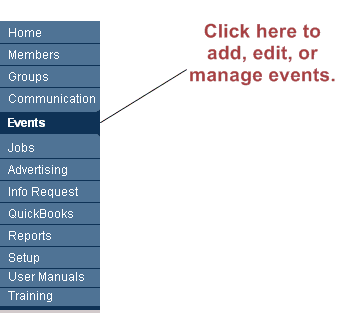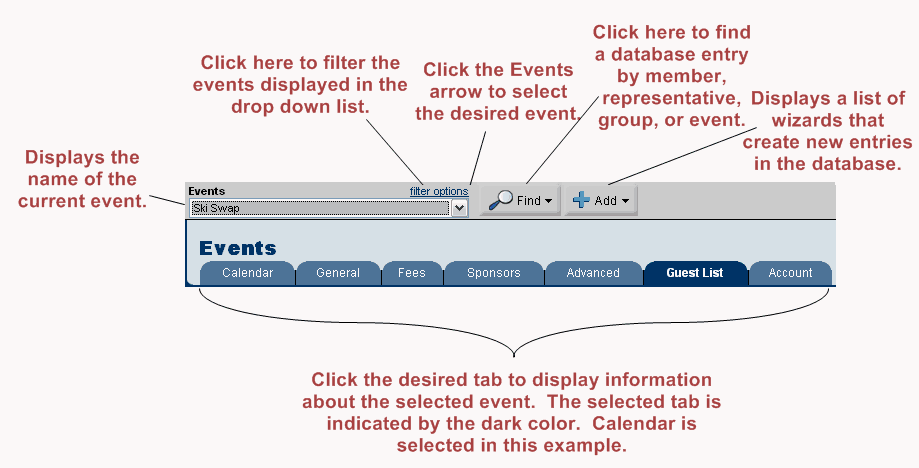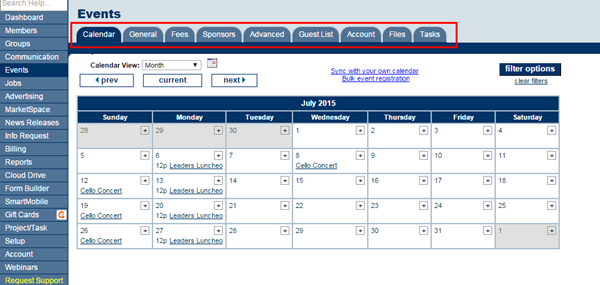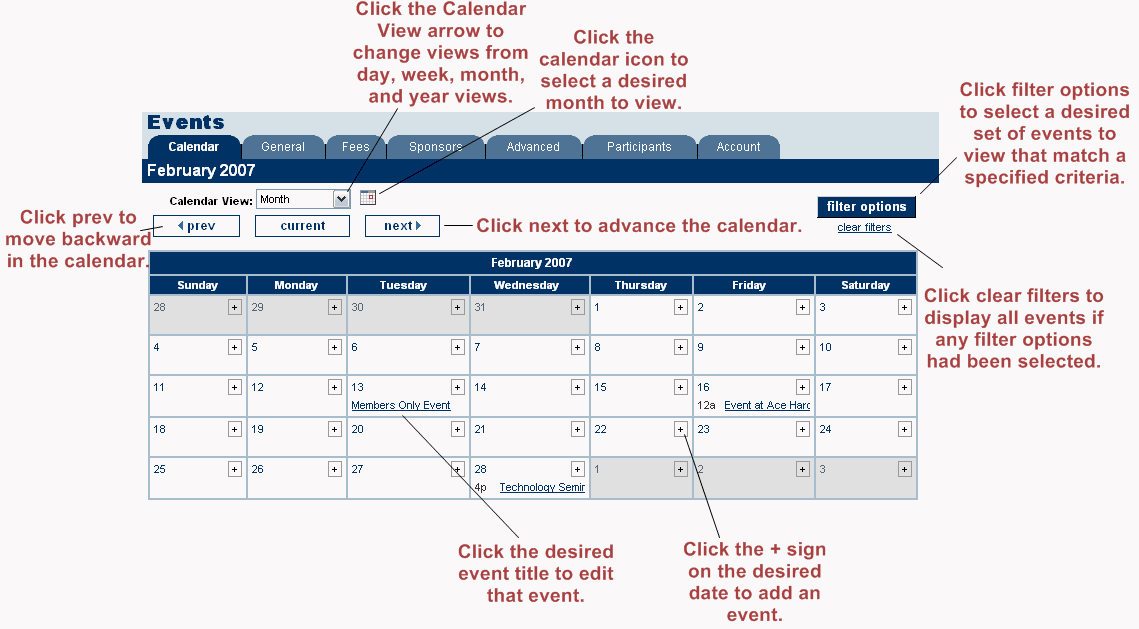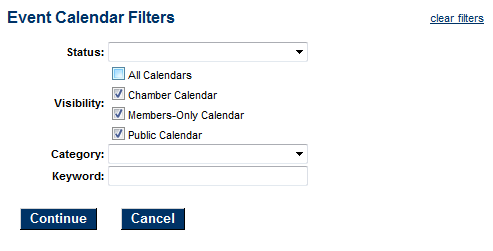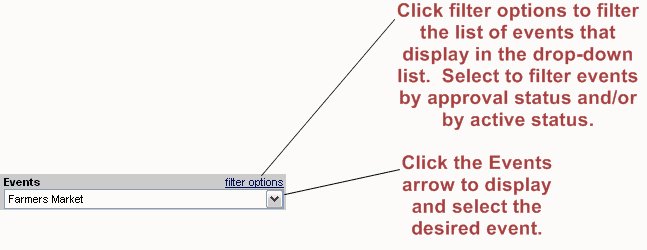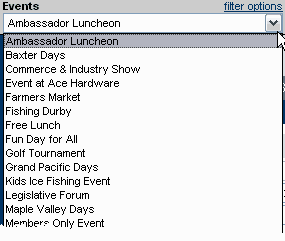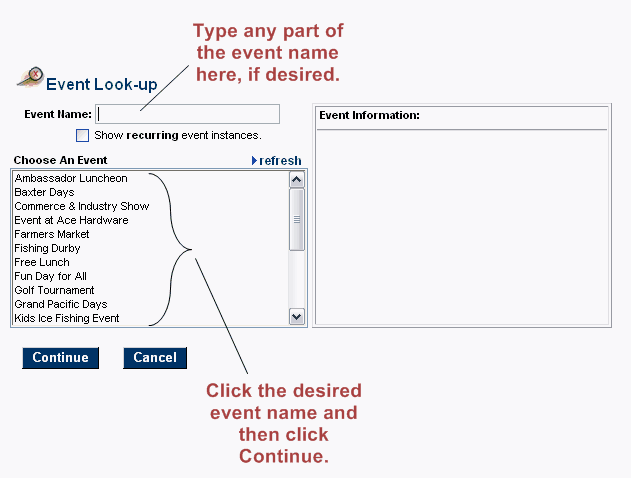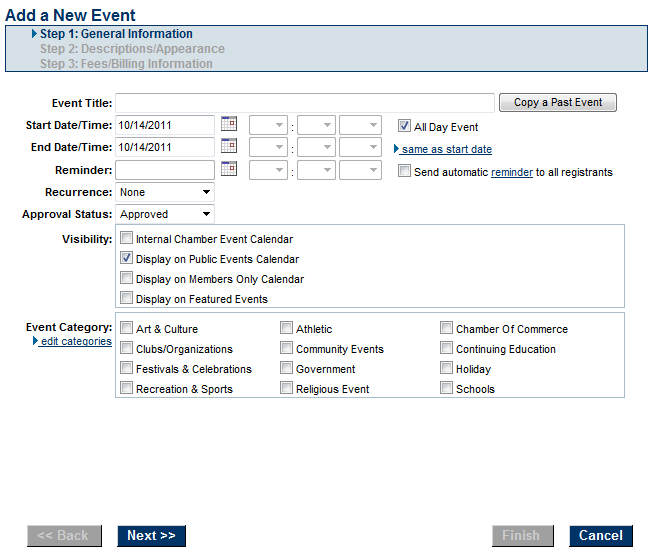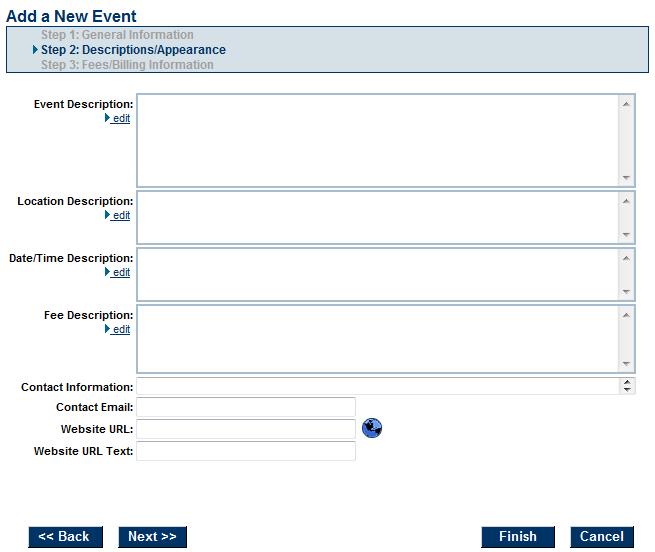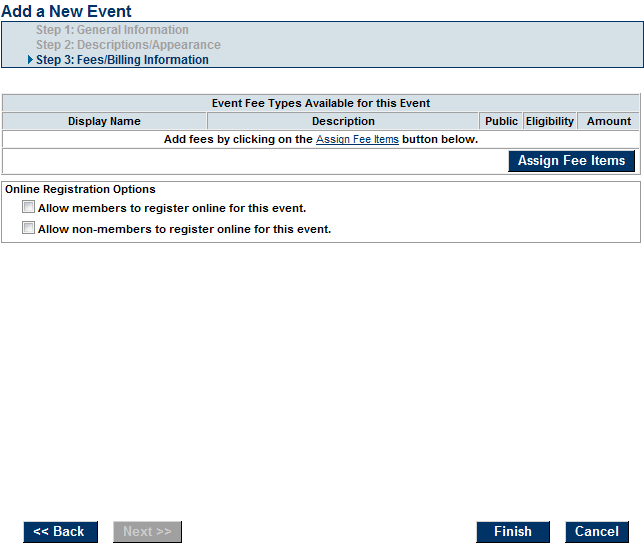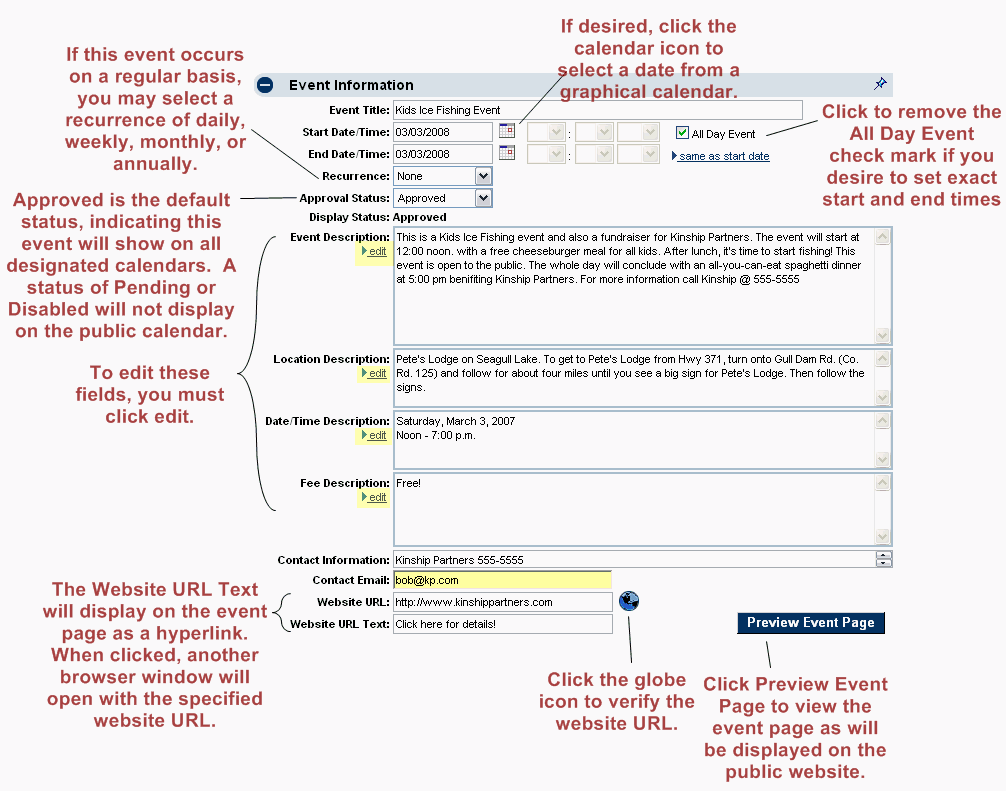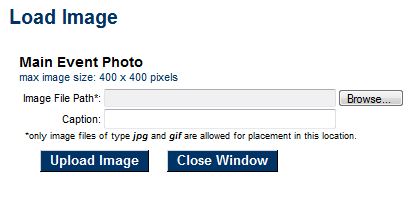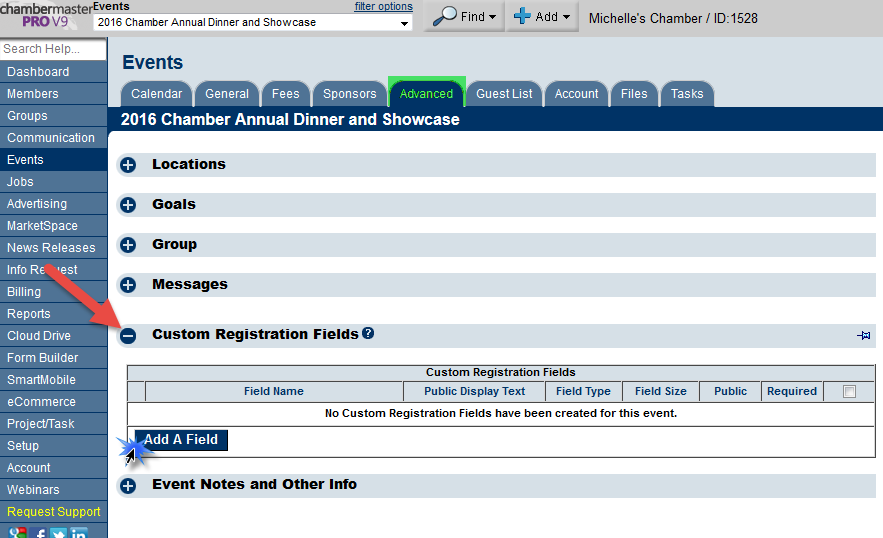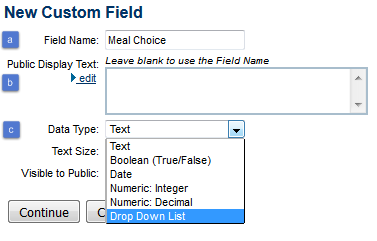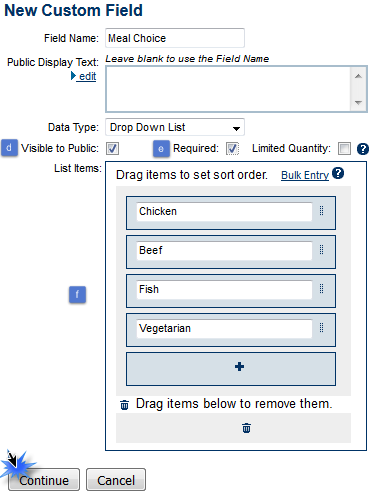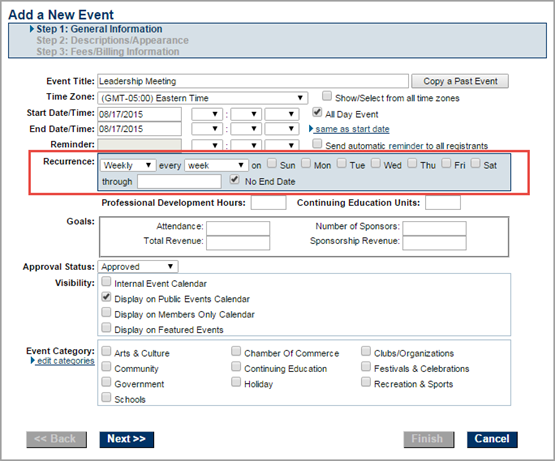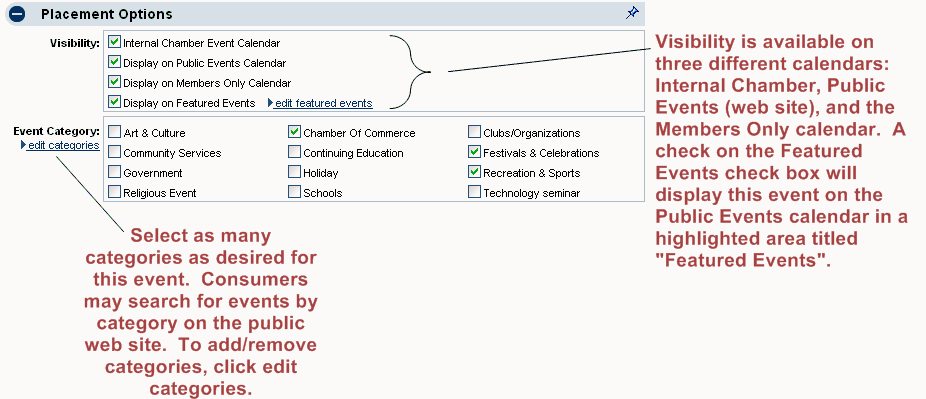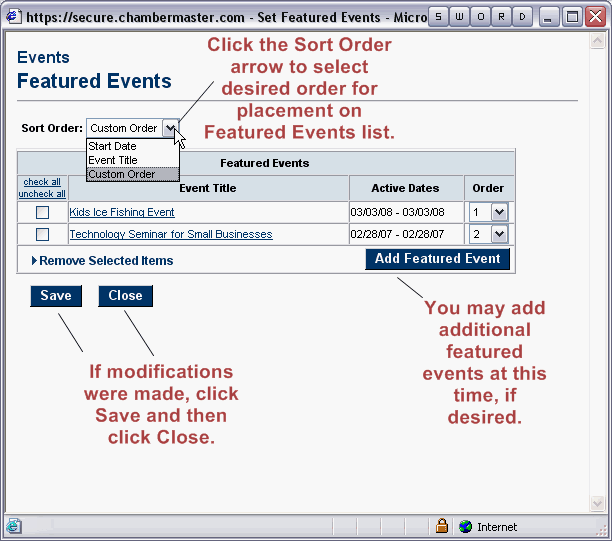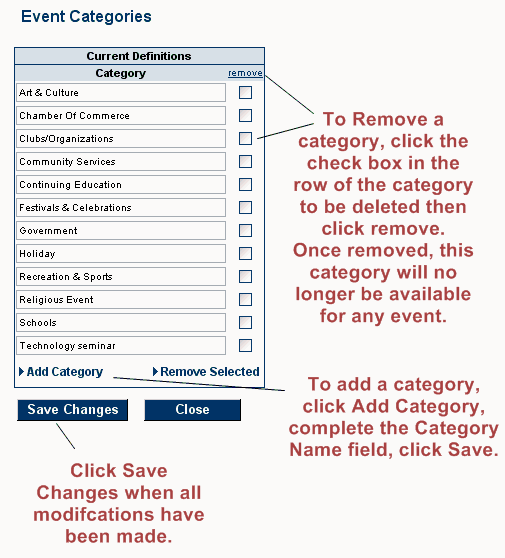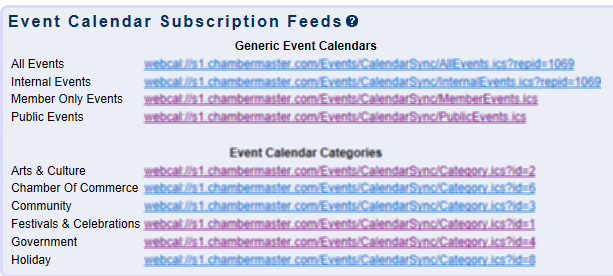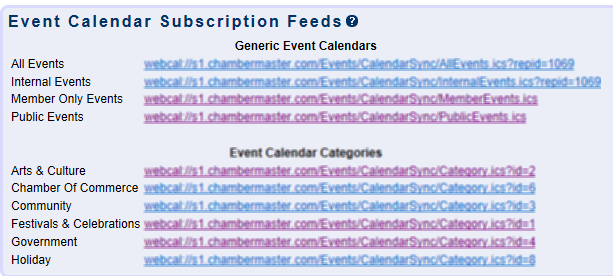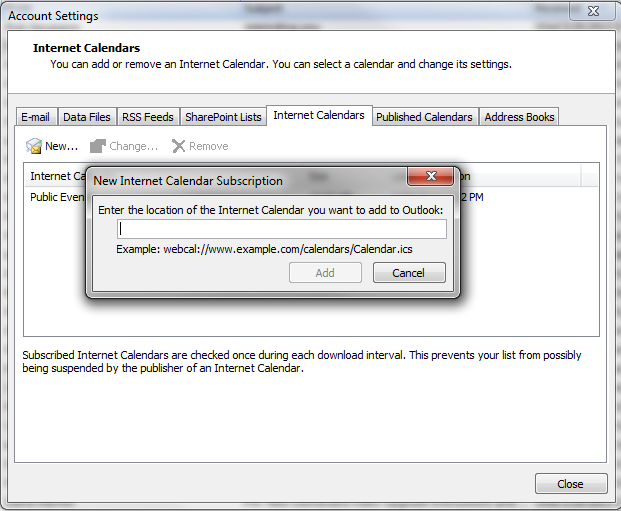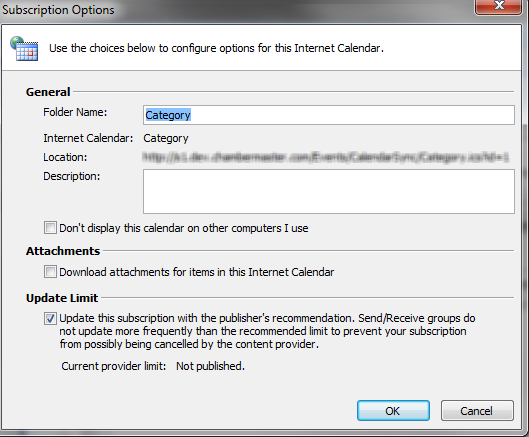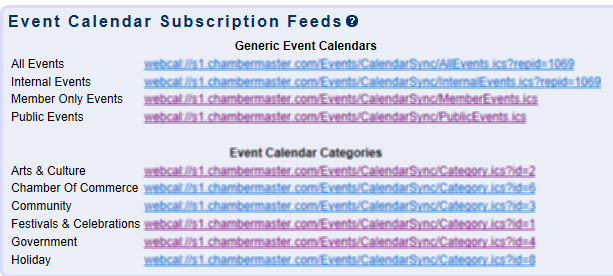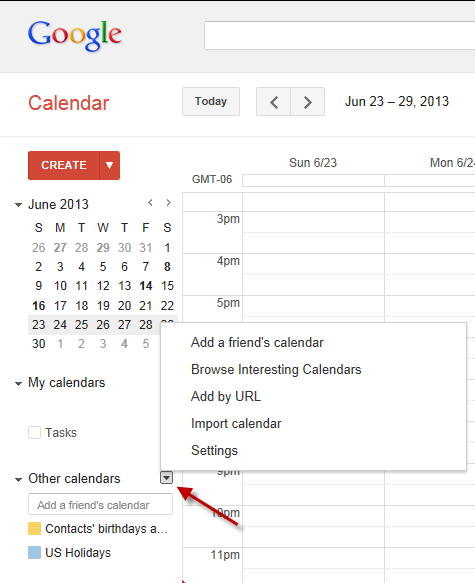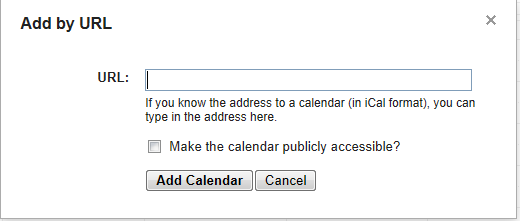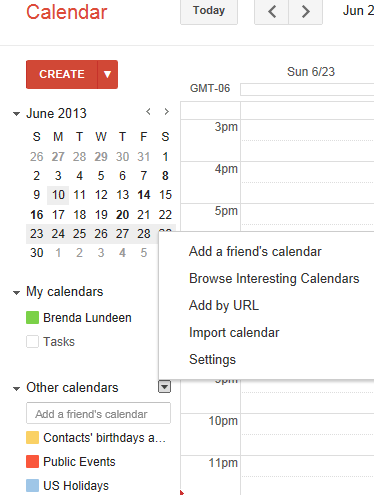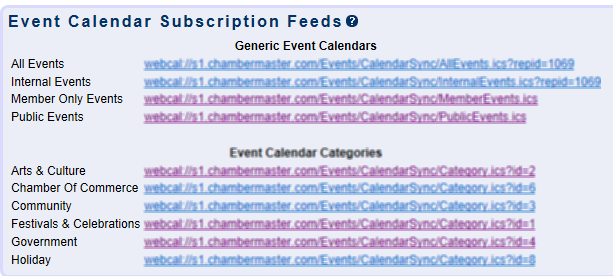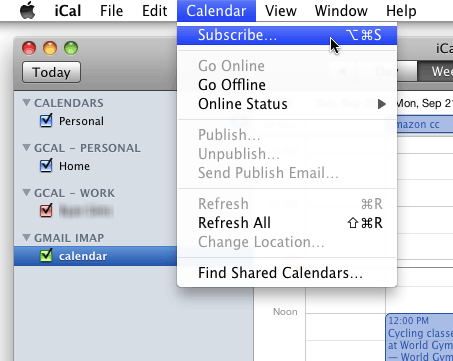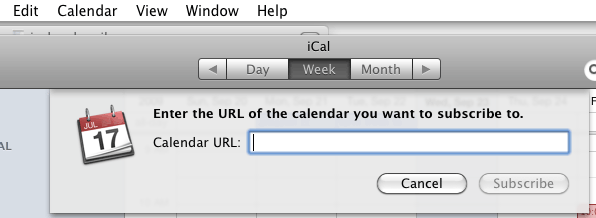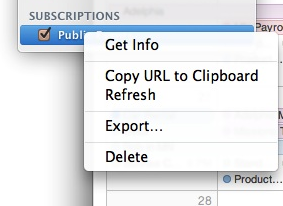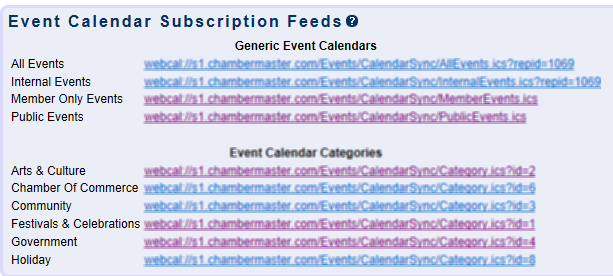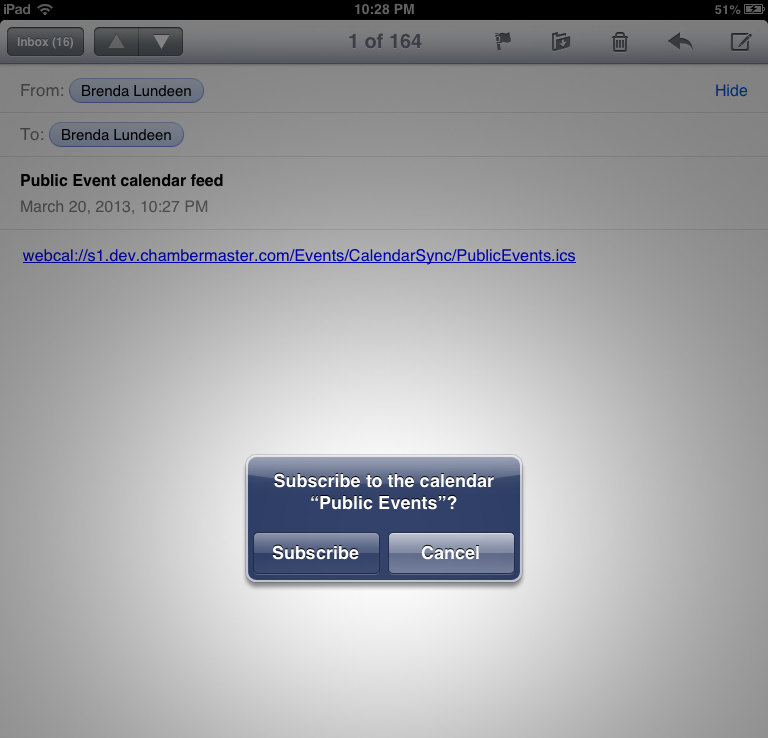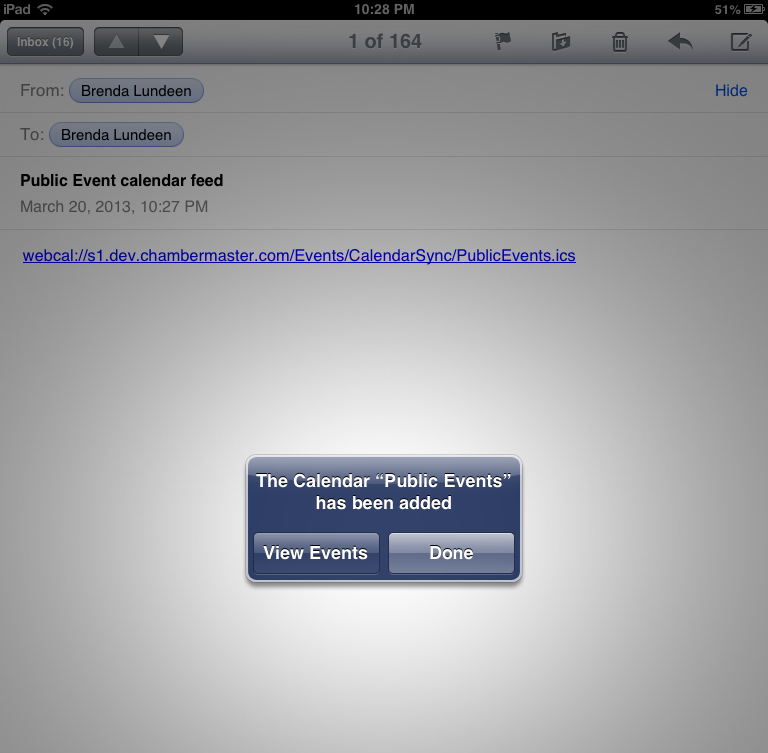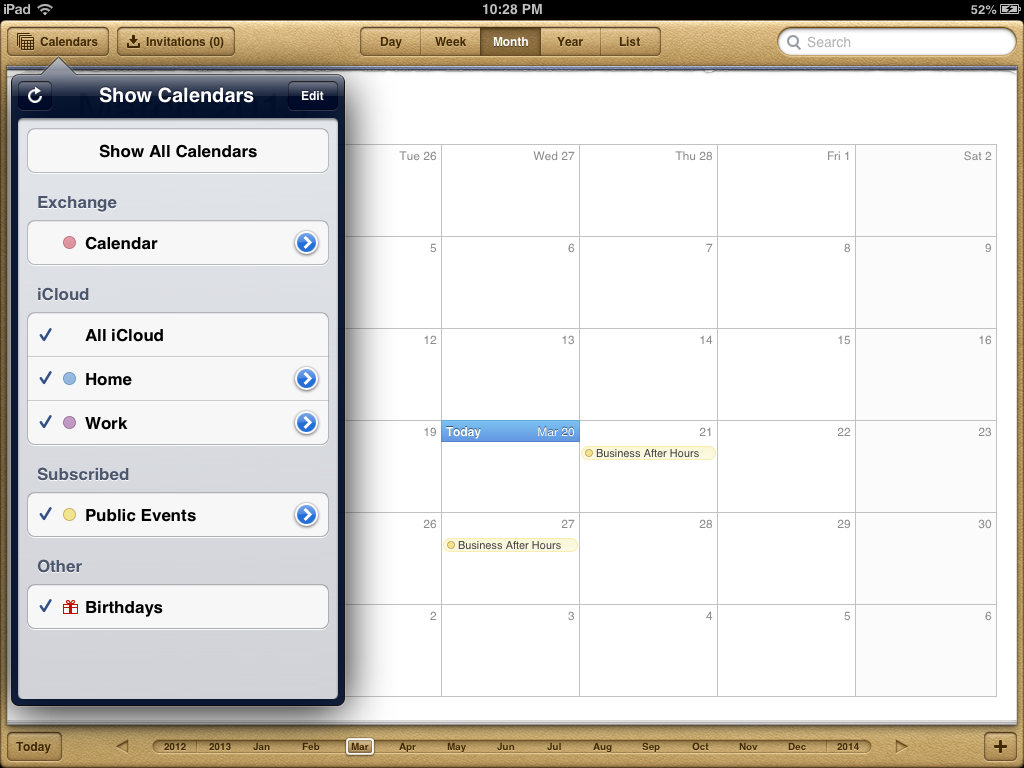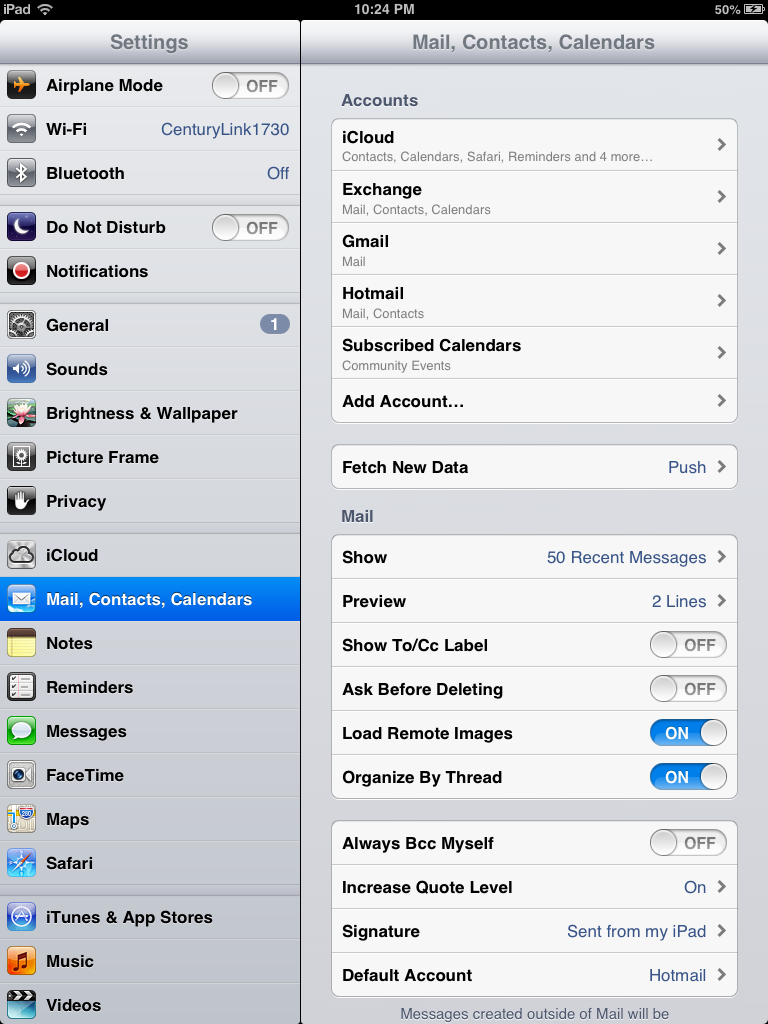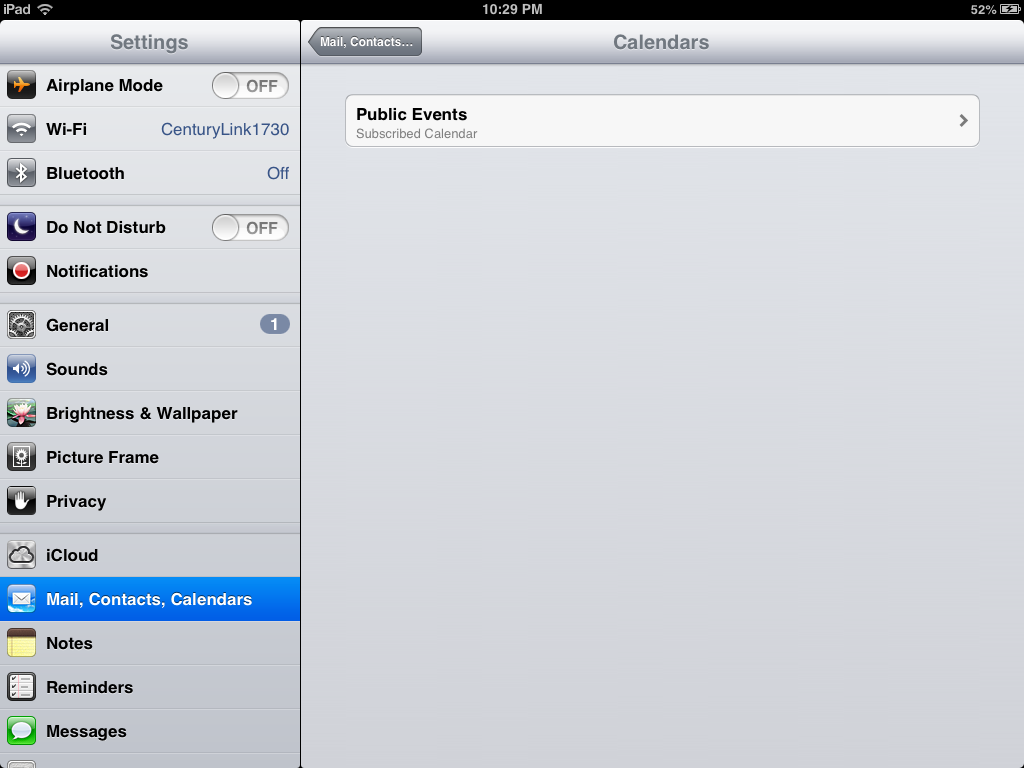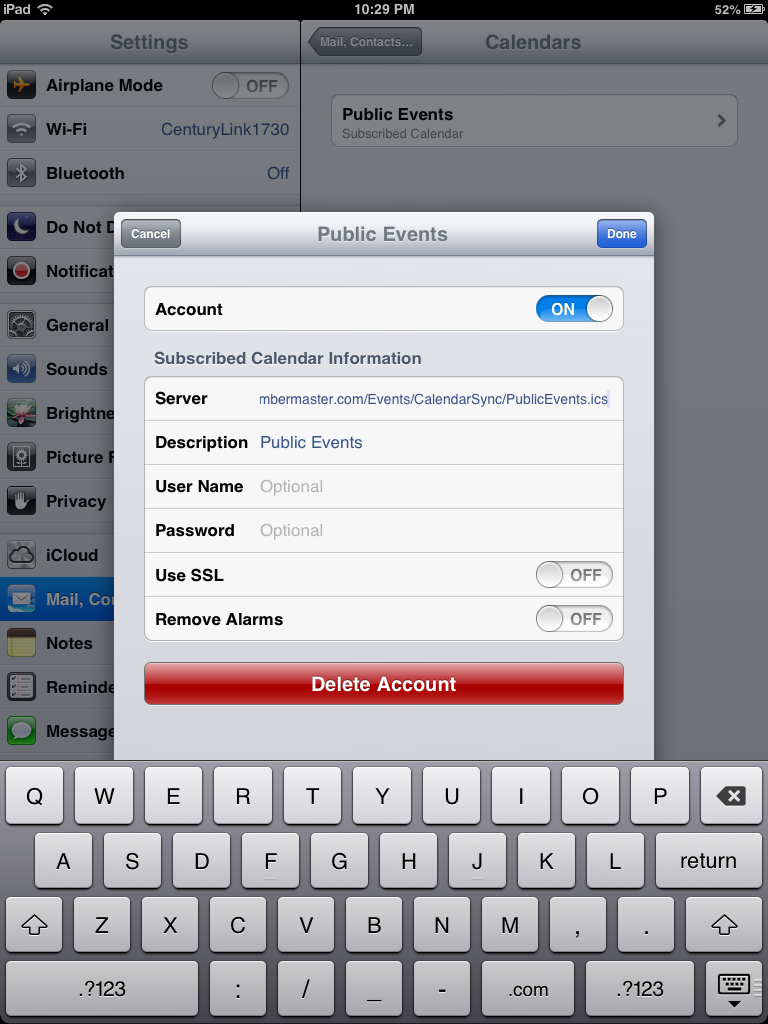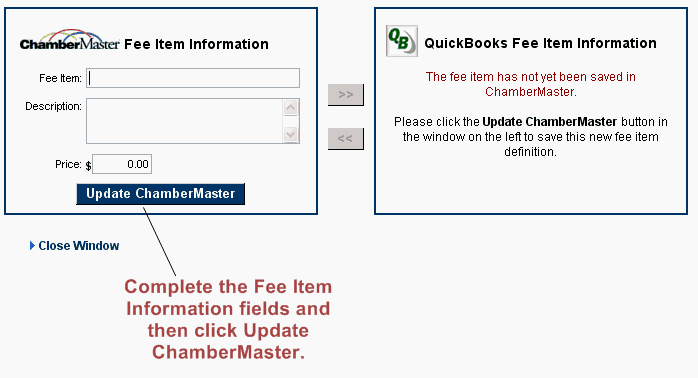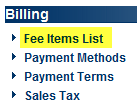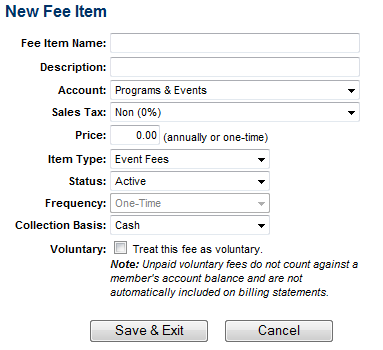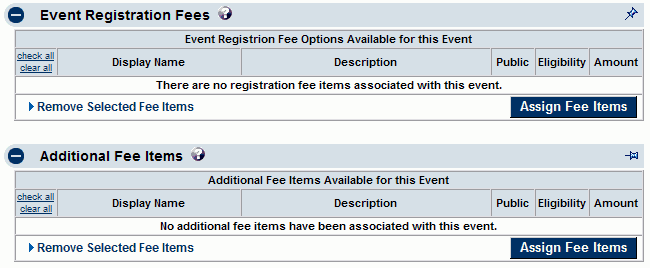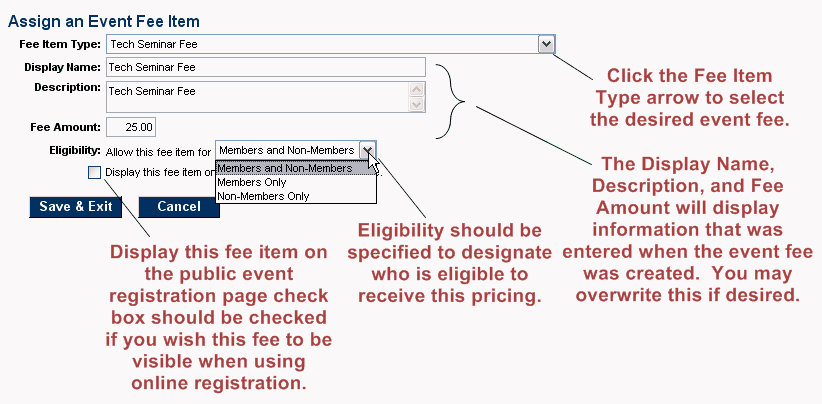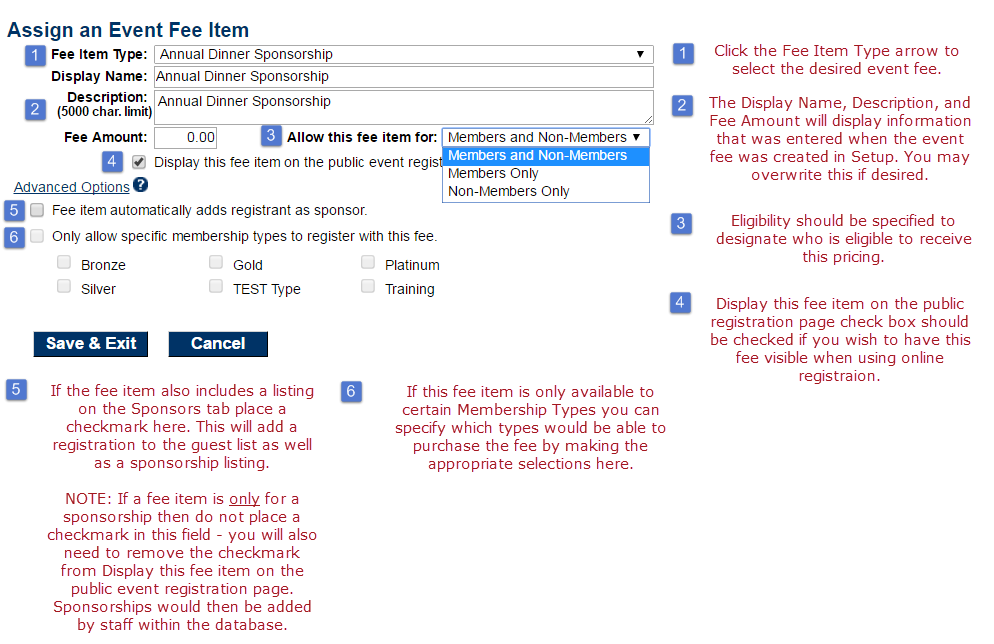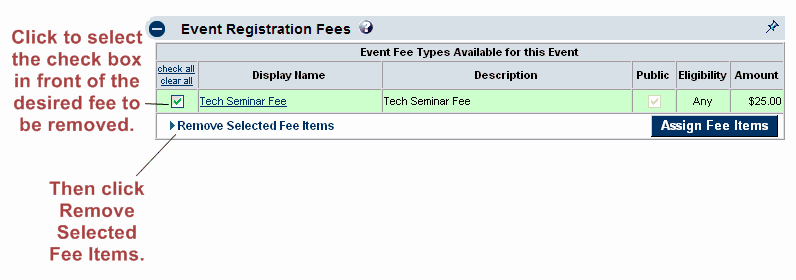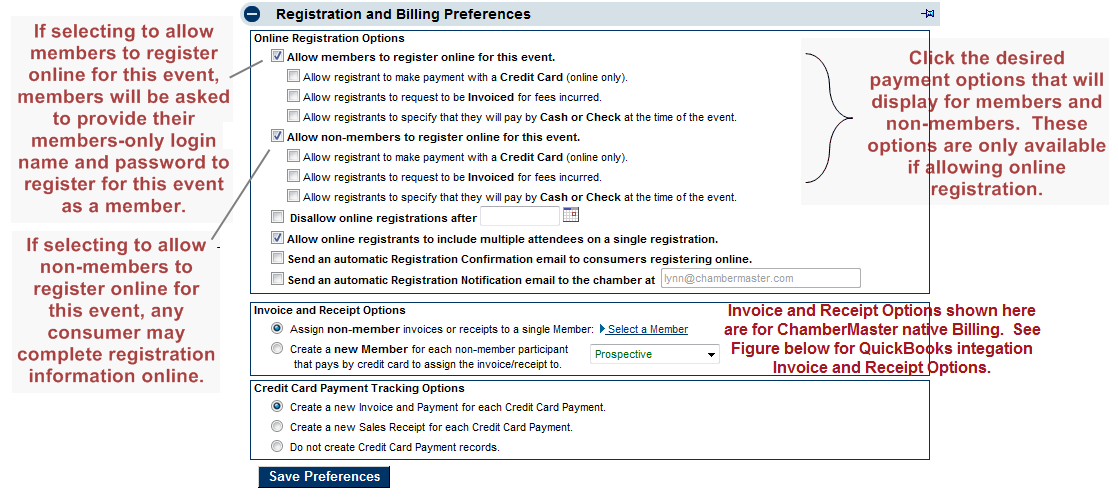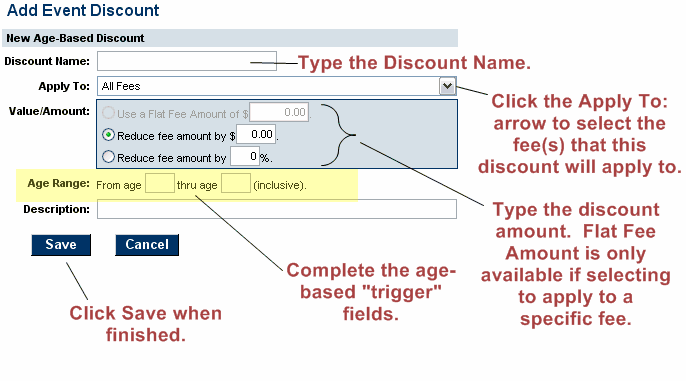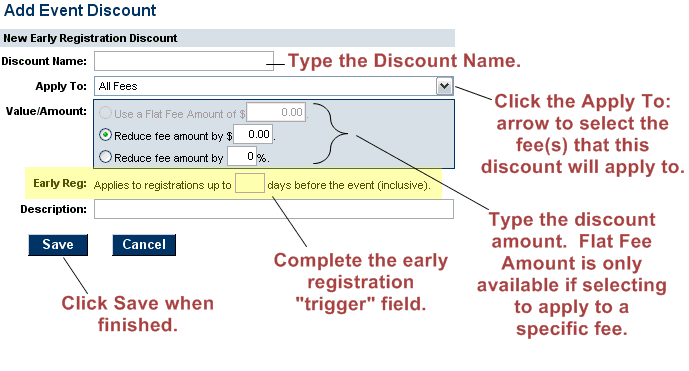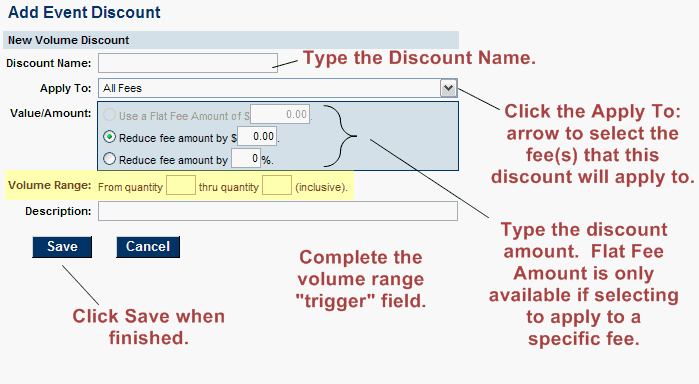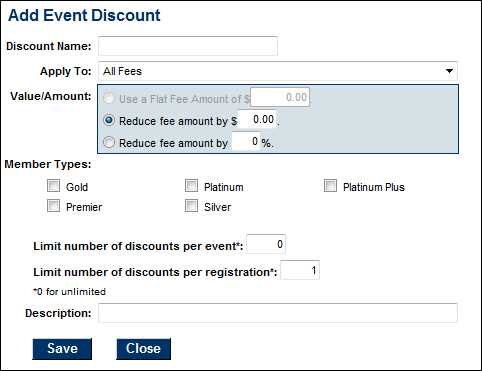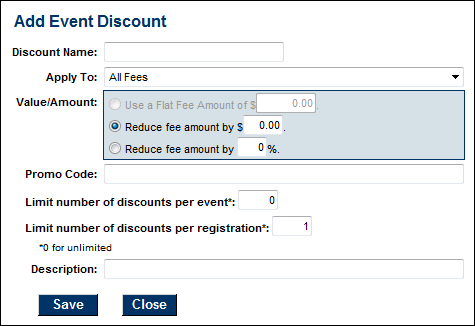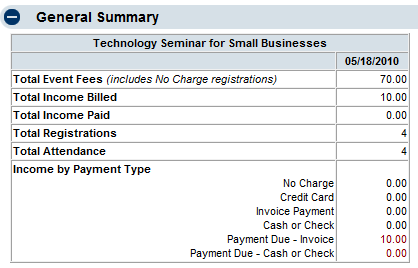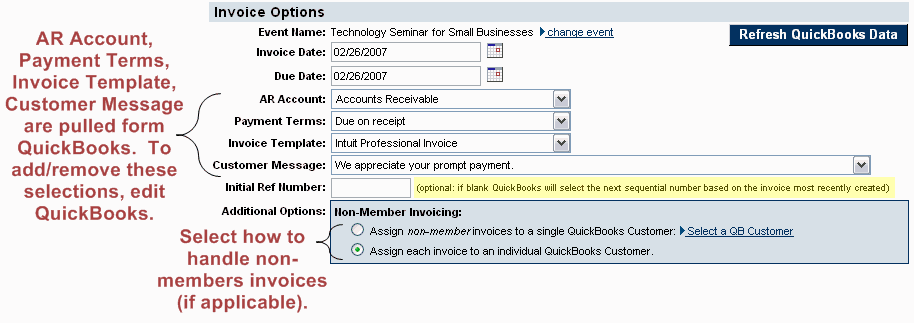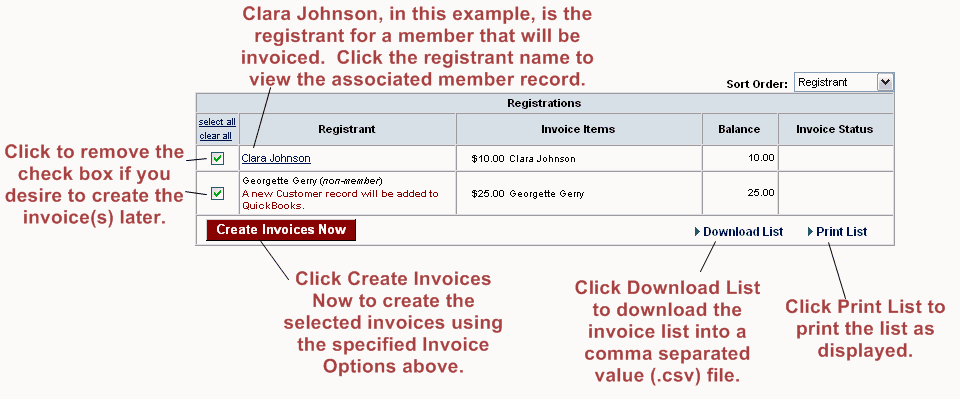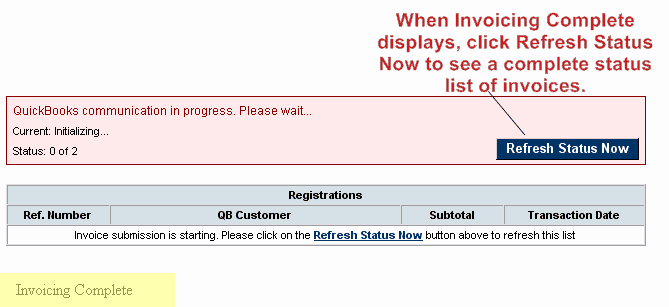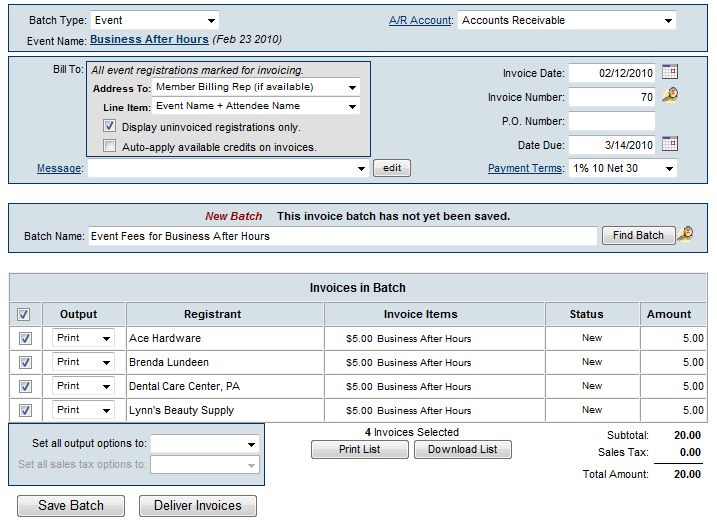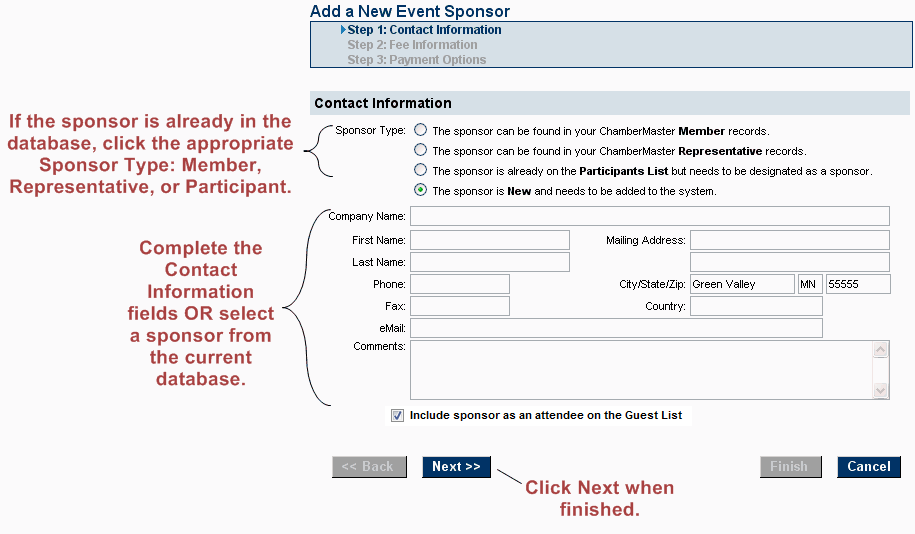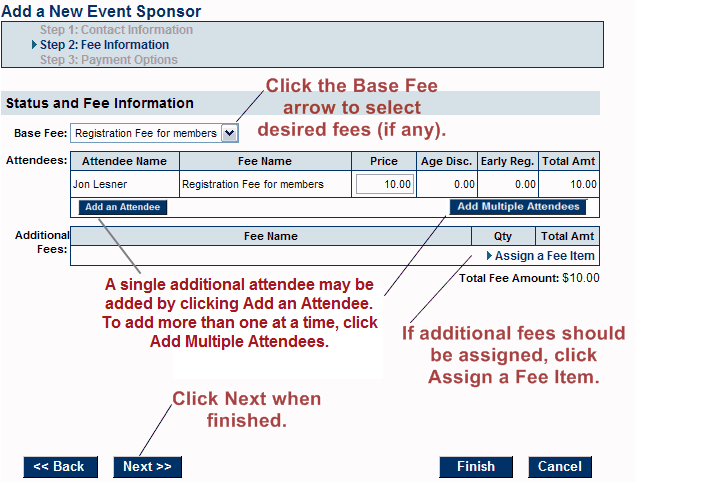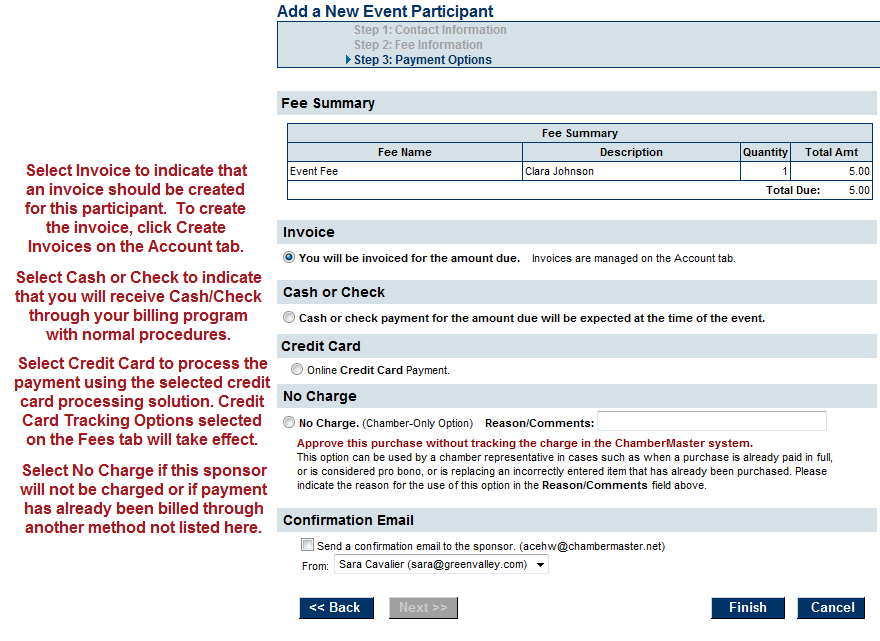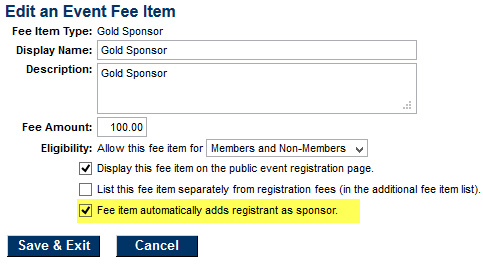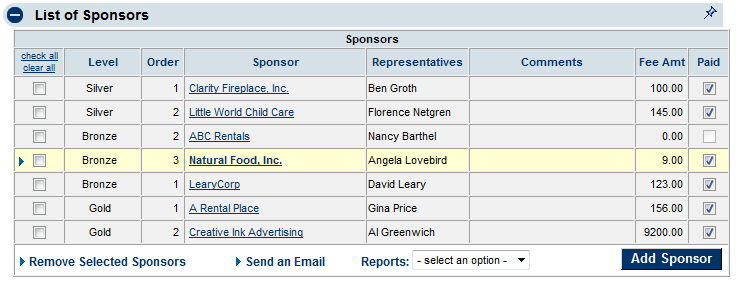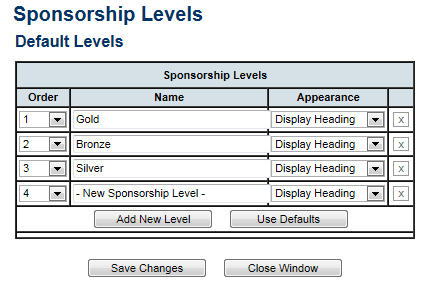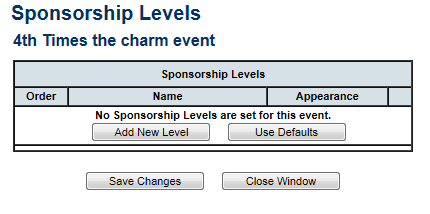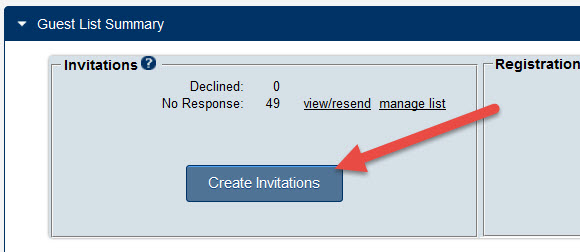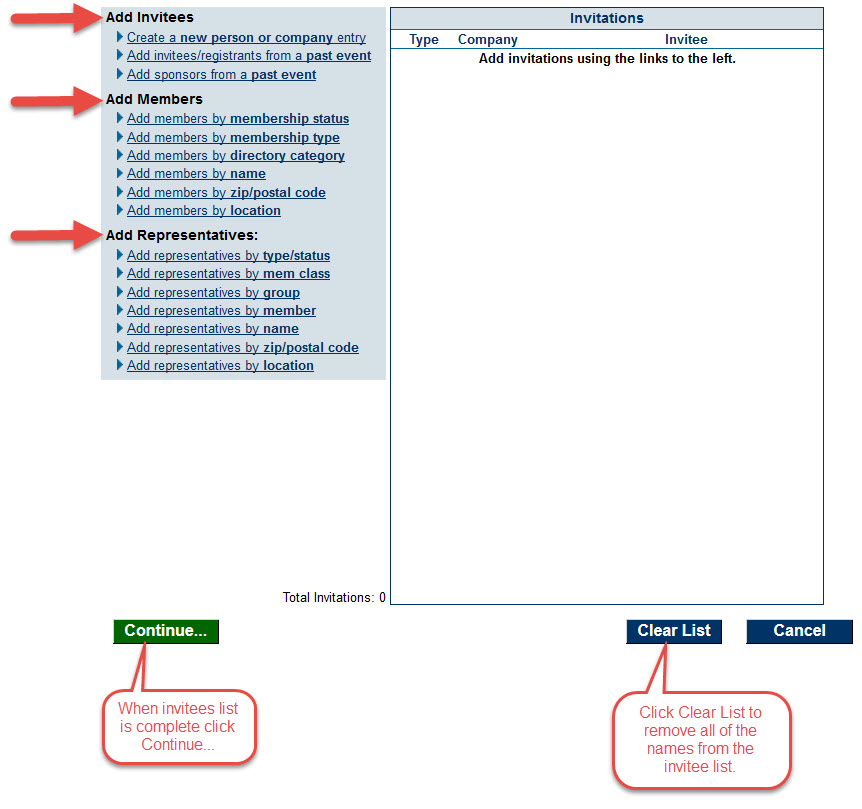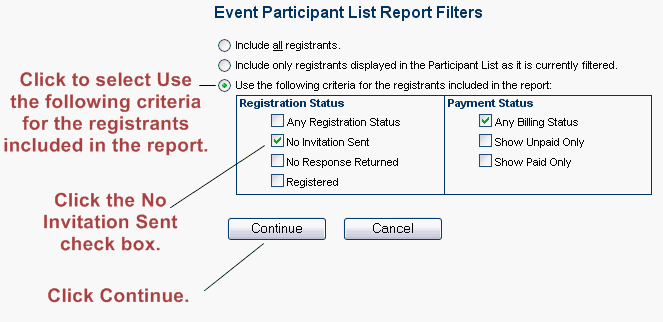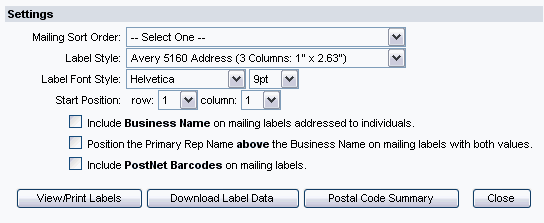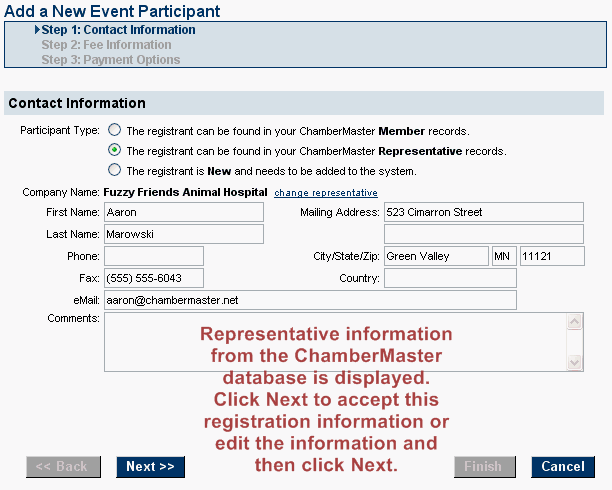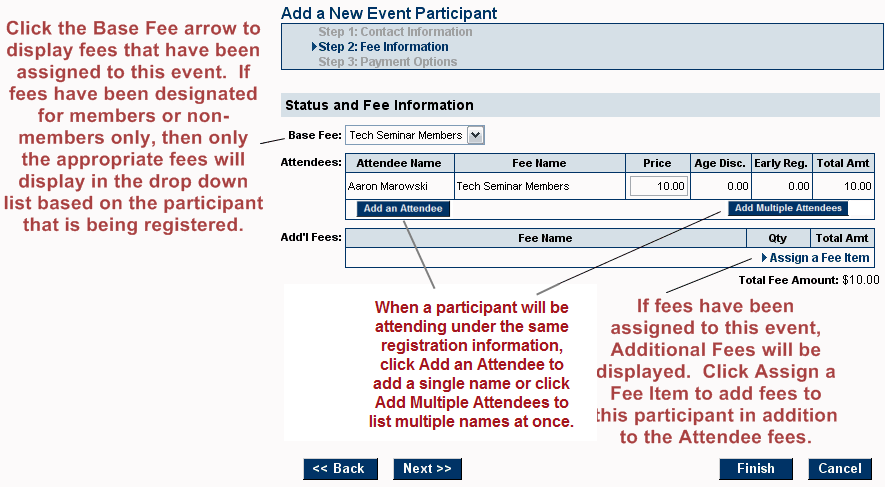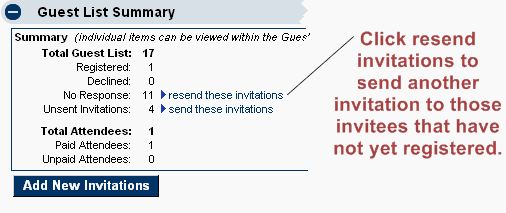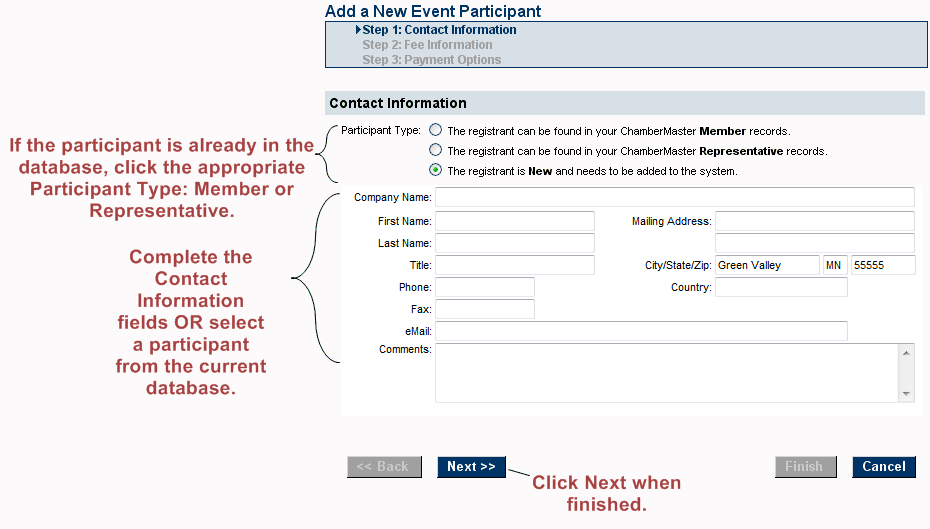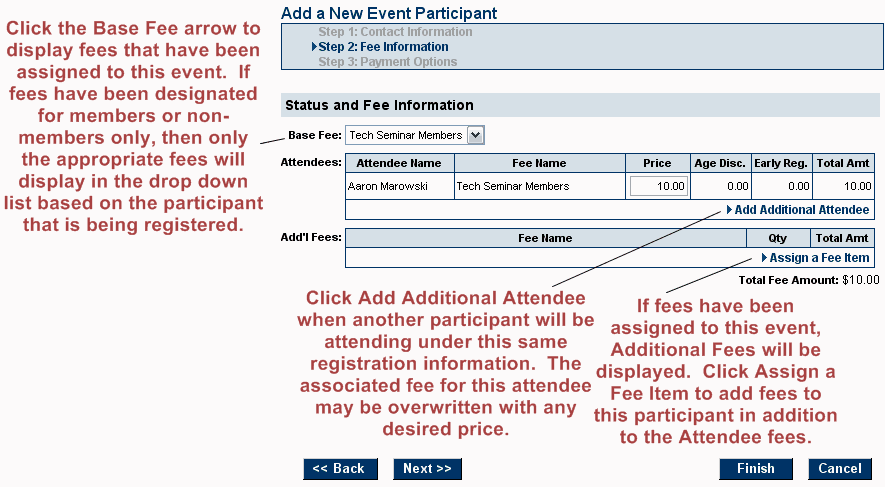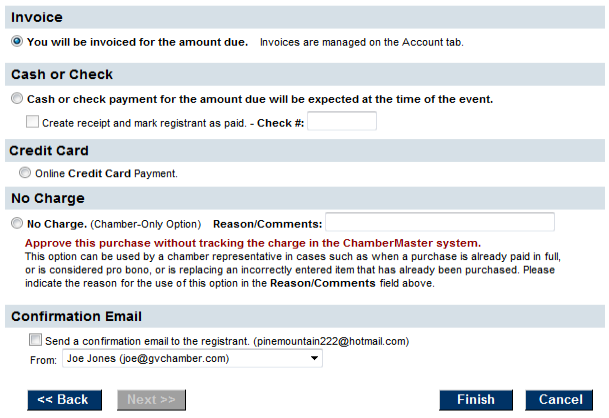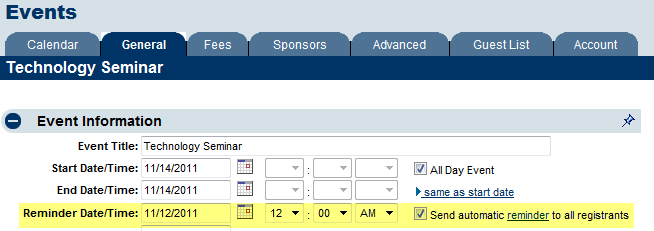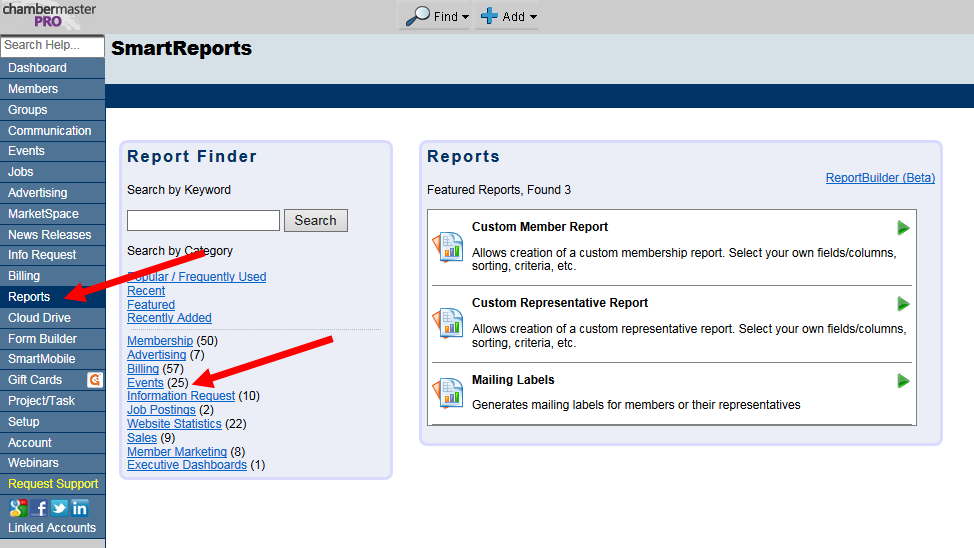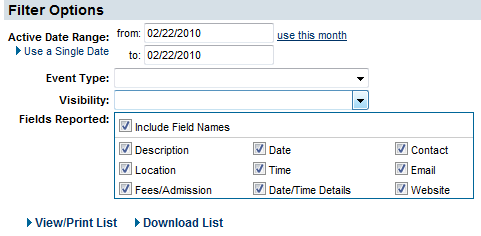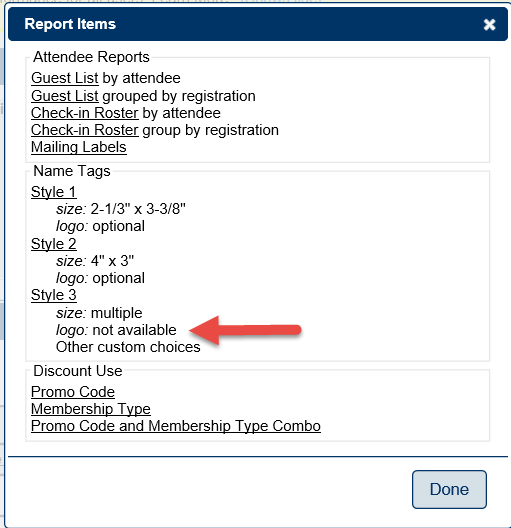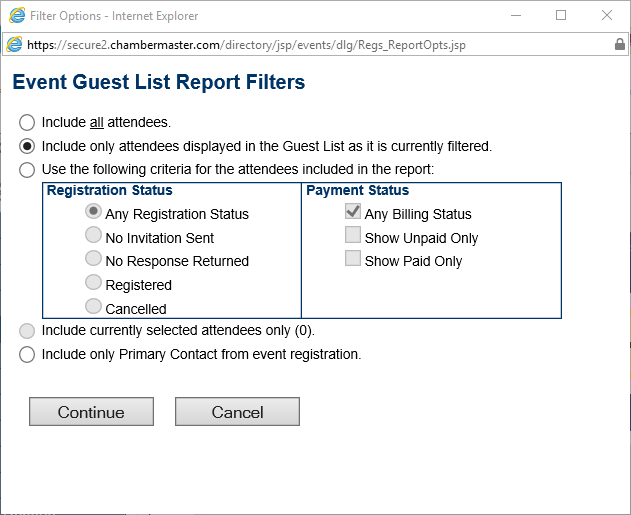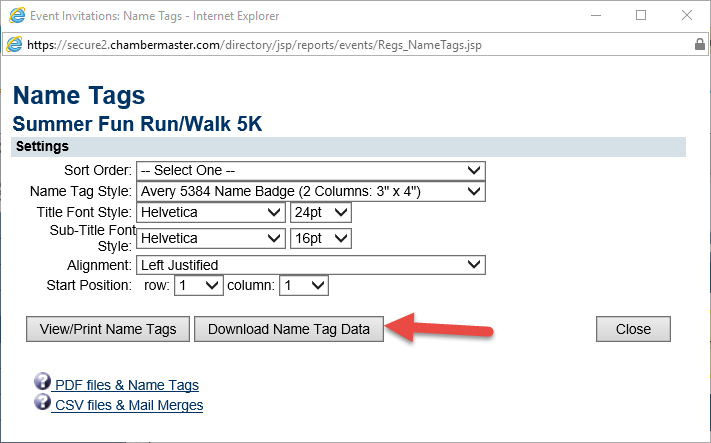Events
Contents
- 1 Getting Started
- 2 Get the Big Picture
- 3 Maintaining the Events Calendar
- 4 Event Fees and Billing
- 5 Sponsors
- 6 Guest List
- 7 Reports and Labels
- 8 Download the Name Tag Data
- 9 Customize Online Event Calendar Display and Registration Options
- 10 FAQ
- 11 Common Tasks
- 12 Help Documentation
Getting Started
If you are just getting started with the Events module, watch this overview video and read Get the Big Picture.
Otherwise, just scroll down for FAQ, Common Tasks, and this module's Help Documentation.
Get the Big Picture
- Events added to your calendar may be enhanced to include photos, sponsor logos and information, website links, and event description text that can be formatted as desired. Options also include online participant registration, special members only pricing, and an automatic email reminder to registered guests.
- Event information may be kept for internal purposes only, displayed on the public website calendar, and/or a calendar available only to chamber members. The public events website displays a graphical monthly calendar, a list of current events, all events for the month, chamber-designated Featured Events, and the ability to search for desired event by category, keyword, or month. A printable listing is also available that contains all pertinent event details.
- Invitations may be sent to potential participants and then automatically displayed on the participants list where their status may be changed from Invite Sent to Registered as RSVPs are received. From the participants list a roster sheet, name tags, or labels may be printed. Other output options include sending emails and downloading data to a comma separated value (.csv) file. Using a variety of filter options all output can be displayed by registration status, payment status, or according to self-selected filters.
- Note: When creating a new event, work with the tabs in order as displayed. For example, after completing the General tab, setup the fees (if applicable) on the Fees tab. The Sponsor tab would be next, the Guest List, and finally the Account tab. You may complete them out-of-order if desired but there is a logical flow if working from left to right.
- Event fees, designated for members or non-members, may be associated with each event. Individual invoices may be generated from the Events module for those requesting an invoice, and if credit card processing is set up then invoices/payments or sales receipts can be recorded automatically upon successful registration.
Maintaining the Events Calendar
Understanding the basics of how the Events module is organized will give a foundation for operation. Viewing existing events and learning to display only desired events will also be helpful. Then learn how to create, modify and manage events.
Event Module Organization
Event Tabs
Within the Events Module there are nine tabs: General, Fees, Sponsors, Advanced, Guest List, Account, Files, and Tasks.
Calendar: Displays the internal events calendar in one of five views: list, day, month, week, or year view. Filter options may also be selected which would display only user-selected events. New events may be added from this tab by clicking the + sign on the desired date/time
General: Event information, placement options, and photos and images
Fees: Assign event fees, billing preferences, and discounts based on age, date, or volume
Sponsors: Designate event sponsors, logos, fees
Advanced: Specify Locations (if available) and Custom Fields
Guest List: Send invitations; add guests to the roster; print roster sheet, labels, and name tags; send emails; register invitees
Account: View income and payment activity, generate invoices and sales receipts (if applicable)
Files:
Tasks: 'Integration with the Project/Task Manager (Pro edition only) When creating a new event, work with the tabs in order as displayed. For example, after completing the General tab, setup the fees (if applicable) on the Fees tab. The Sponsor tab would be next, the Guest List, and finally the Account tab. You may complete them out-of-order if desired but there is a logical flow if working from left to right.
Working with the Calendar Tab
The Calendar tab displays an Events calendar that may be displayed in five different views: list, day, week, month, and year view. As the name suggests, List view displays all events in a list format. The day, week, and month view will display all events falling within the specified date range. The year view displays a graphical calendar allowing chamber employees to advance quickly to a particular date.
The calendar may also be filtered to display only certain events matching the desired criteria. Click clear filters to display all events again.
View the Internal Events Calendar
1. |
Click Events in the left-hand menu. |
2. |
On the Calendar tab, click the Calendar View arrow to select the desired view. |
3. |
If necessary, click Prev and Next to decrease or advance the calendar. Alternatively, you may click the calendar icon and select the desired month to view. |
Filter the Internal Events Calendar (display only specified events)
2. |
Select the desired filter options. See Figure 2-4 and Table 2-2 below. |
3. |
Click Continue. |
4. |
When finished viewing the filtered list of events, click clear filters to view all events. |
Event Calendar Filters
Selecting an Event
Select an Event Using the Drop Down List
1. |
Within the Events module, click the drop-down arrow to the right of the Event name. See Figure 2-6. |
2. |
In the Events list, click the desired event name. |
Select an Event Using the Find Button
1. |
On the Find menu, click Event. |
2. |
If desired, in the Event Name box, type any part of the event name. (This will limit the list of displayed events to those matching your criteria.) |
3. |
In the Choose an Event list, click the desired event name. |
4. |
Click Continue. |
Select an Event Using the Calendar View
1. |
In the Events module, click the Calendar tab. |
2. |
Advance the calendar to display the desired event. |
3. |
Click on the desired event title. |
Adding an Event
When adding a new event, you simply fill in the requested information as the wizard walks you through three information screens. You will be asked to fill in the following information screens:
- General Information
- Descriptions/Appearance
- Fees/Billing Information
When you click Finish, your event is automatically added to the designated event calendar(s).
You may add an event using one of two methods. Adding an event to the calendar may be done at any time using the Add menu and when by clicking the +sign when the Calendar tab is displayed, which uses the calendar to assist in date selection, or by nightly importing your iCal feed.
Add an Event
1. |
On the Add menu, click Event. |
2. |
Complete the General Information fields and click Next. |
3. |
Complete the Descriptions/Appearance fields and click Next. |
4. |
Complete the Fees/Billing Information fields and click Finish. |
Importing Events from an iCal Feed
The iCal feed import provides an ability for customers to upload their iCal list (from the Cloud drive or other http url used with iPhones, iPads etc and other similar calendars) and import directly into the event calendar. A URL is specified to the location of this iCal and then each night the events are synched. To import iCal feeds into the event calendar
- Click Setup in the left-hand menu.
- Click Event Options and Settings
- Open the General Settings area.
- Click the +Add button in the iCal Import section.
- Type the URL of the iCal feed.
- Click Save.
| Note: Once an iCal has been added, the events on that calendar may take up to 24 hours to display on your event calendar. |
| Note: Recurring events are not supported with the iCal import feature. |
Editing Event Information
Edit Event Information
1. |
In the Events module, select the desired event. See “Selecting an Event.” |
2. |
On the General tab, modify the desired Event Information fields. |
3. |
Click Save. |
Photos and Images
Add a Main Event Photo or a New Gallery Photo
1. |
On the General tab, click Add Image in the Action column of the Image Type that you wish to add in the Photos & Images area. |
2. |
Type the path and filename of the desired graphic file or click Browse to locate and click Open when desired graphic is located. |
3. |
Click Upload Image. |
4. |
Optional: If adding a Main Event photo, you may also complete the Caption field and then click save caption. |
5. |
Click Close Window. |
Remove a Main Event Photo or a Gallery Photo
1. |
On the General tab, click Remove Image in the Action column of the Image Type that you wish to remove in the Photos & Images area. |
Change an existing Main Event Photo or Gallery Photo
1. |
On the General tab, click Change Image in the Action column of the Image Type that you wish to change in the Photos & Images area. |
2. |
Type the path and filename of the desired graphic file or click Browse to locate and click Open when desired graphic is located. |
3. |
Click Upload Image. |
4. |
Click Close Window. |
Add a Video
1. |
On the General tab, click Add Video in the Action column in the Photos & Images area. |
2. |
Type or paste the YouTube “share link” for the desired video into the Event Video field. |
3. |
Click Save. |
Add a Map Image
1. On the Web tab, click the desired Map Image option button in the Image Type column in the Web Photos & Images area.
2. If selecting Uploaded Image, then click Add Image in the Action column. Type the path and filename of the desired graphic file or click Browse to locate and click Open when desired graphic is located. Click Upload Image. Click Close Window.
3. If selecting Google Maps or MapQuest, complete the address fields and then click Save.
Add Custom Fields
1. From the Advanced tab click to expand Custom Registration Fields, then click Add a Field
2. Create the custom registration field by completing the following:
- a. Field Name
- b. Public Display Text (optional)
- c. Select Data Type
- d. Designate whether or not custom field will be a publicly displayed field
- e. Designate whether or not custom filed is required
- f. (If data type is Drop Down List) Enter drop down selection items
Create a recurring event
Video: Create a Recurring Event 
If your association has an event which occurs on a regular basis, save time by setting it up as a recurring event. Most the details of the original event will be applied to the recurring instances. A notable exception is Fees, which must be set for each instance.[1]
- Important: Once an event is listed as a recurring event, each event instance will be displayed on the calendar at the appropriate date/time where the instance may be modified on an individual basis or ALL instances may be changed at once by editing the original occurrence.
- Note: After an instance has been edited individually, it will no longer accept the changes from the original occurrence.
- Figure: Recurrence options in the "Create a New Event" screen.
Set the recurrence of an event
1. |
On the General tab, click the Recurrence arrow and click the desired recurrence. |
2. |
Complete the Recurrence fields for the selected recurrence. |
Edit a specific instance
1. |
On the Calendar tab, advance to the date of the desired instance. |
2. |
Click the title of the event. |
3. |
Modifications made will only affect this specific instance. (You may even delete a specific instance without affecting the others.) |
To edit all event instances
1. |
On the Calendar tab, click the title of any event instance of the desired event. |
2. |
In the Recurrence field, click the title of the original event. |
Placement Options
Select placement options
1. |
On the General tab, click the desired visibility check box(es). |
2. |
Click Save. |
3. |
If selecting Display on Featured Events, complete the Featured Events window by selecting Sort Order and desired Order. Then click Save and Close. |
Select an event category
1. |
On the General tab, click the desired Event Category(ies) check box(es). |
2. |
Click Save. |
Edit event categories
1. |
On the General tab, click edit categories in the Placement Options area. |
2. |
Make the desired modifications. See Figure 2-20. |
3. |
Click Save Changes. |
Deleting an Event
Permanently delete an event
2. |
Click OK. |
Syncing with your calendar
1. |
Click Events in the left-hand menu. |
2. |
Click the Calendar tab. |
3. |
Click “Sync with your own calendar.” |
4. |
Click the desired link and follow the prompts to synchronize with the default calendar on your system (if available). |
5. |
To synchronize with a different calendar, copy and paste the desired URL into your calendar software in the location where feeds are accepted, often identified with “Subscribe”, “Add Calendar”, etc. |
6. |
Your 3rd party calendar will automatically update every hour with any changes made to your events. |
Sync Events with Outlook
1. |
Click Events in the left-hand menu. |
2. |
Click the Calendar tab and click “Synch with your own calendar.” |
3. |
Locate the desired event feed. |
4. |
Highlight the URL and copy it. (Right click on the highlighted URL and click Copy) |
5. |
Open your Outlook software. |
6. |
Click File, Date File Management. |
7. |
Click the Internet Calendars tab. |
8. |
Click New... |
9. |
Paste the URL. (Right click and click Paste.) |
10. |
Click Add. |
11. |
Click OK on the Subscription Options window. |
Synch your events with Google Calendar
1. |
Click Events in the left-hand menu. |
2. |
Click the Calendar tab and click “Synch with your own calendar.” |
3. |
Locate the desired event feed. |
4. |
Highlight the URL and copy it. (Right click on the highlighted URL and click Copy) |
5. |
Open a browser window and login to your Google Calendar. |
6. |
Click the arrow next to Other calendars. |
7. |
Select Add by URL. |
8. |
Paste the URL into the URL field and click Add Calendar. |
1. |
When logged into your Google Calendar, click the arrow next to Other calendars. |
2. |
Select Settings. |
3. |
At the bottom of the screen in the Other Calendars area, click Unsubscribe to the right of the calendar that you wish to remove. (Public Events in the example below.) |
4. |
Click Unsubscribe. |
Synch your events with Apple iCalendar
1. |
Click Events in the left-hand menu. |
2. |
Click the Calendar tab and click “Synch with your own calendar.” |
3. |
Locate the desired event feed. |
4. |
Highlight the URL and copy it. |
5. |
Open your iCal software. |
6. |
Select the Calendar menu and click Subscribe. |
7. |
Paste the copied URL into the Calendar URL field. |
8. |
Click Subscribe. |
9. |
After the feed is loaded, you have the option of changing some of the settings if you wish. |
10. |
Click OK. |
1. |
From the Calendars menu, right click (control) the calendar under the Subscriptions section. |
2. |
Click Delete. |
3. |
From the Calendars menu, right click (control) the calendar under the Subscriptions section. |
4. |
Click Get Info and set Auto-Refresh to None. |
Synch your events with your iPad or iPhone
1. |
Click Events in the left-hand menu. |
2. |
Click the Calendar tab and click “Synch with your own calendar.” |
3. |
Locate the desired event feed. |
4. |
Highlight the URL and copy it. (Right click on the highlighted URL and click Copy) |
5. |
Send yourself an email with URL pasted into it. |
6. |
On your iPad or iPhone open that email. |
7. |
Click the URL. |
8. |
Click Subscribe. |
9. |
The feed will load and provide a message. |
10. |
Click Done. |
11. |
The calendar will appear in your iPad calendar. |
1. |
Select Settings. |
2. |
Select Mail, Contacts, Calendars. |
3. |
Select Subscribed Calendars. |
4. |
Select your subscribed calendar to be removed. (Public Events in example below.) |
5. |
Select Delete Account. |
Event Fees and Billing
Events that require a fee to participate can be managed through the Events module. Event fees, designated for members or non-members, may be associated with each event. If allowing online registration, members-only pricing is available to those with a members-only login name and password.
Staff control what payment options appear for members and non-members, with a separate set of options available for each. If integrated with QuickBooks or using the integrated billing module, individual invoices may be generated from the Events module for those requesting payment by invoice.
Discounts based on age, date, or volume may be created for each event and applied when appropriate information is provided during registration.
The Account tab displays a running total of the event income activity in addition to a summary of guest list information.
Setting up and using event fees require the following steps:
- Create Event Fees
- Assign Event Fees
- Select Billing Preferences
- Create Discounts Options
- View Account Information
- Create Event Invoices
Create Event Fees with CQI (Legacy)
Note: CQI is a legacy product.
7. |
Click QuickBooks in the left-hand navigation bar. |
8. |
Click the Event Fees tab. |
9. |
Click Add Fee Items. |
10. |
Click Define a New Fee Item. |
11. |
Complete the Fee Item Information screen. |
12. |
Click Update ChamberMaster. |
13. |
If the fee does not exist in QuickBooks yet, click Add Fee Item to QuickBooks Now. |
14. |
Click Close Window. |
1. |
Click QuickBooks in the left-hand navigation bar. |
2. |
Click the Event Fees tab. |
3. |
Click Add Fee Items. |
4. |
From the list of QuickBooks items and services click the check box in front of the QuickBooks Fee Item that you desire to add to ChamberMaster / MemberZone. |
5. |
Click Save & Exit. |
1. |
Click QuickBooks in the left-hand navigation bar. |
2. |
Click the Event Fees tab. |
3. |
Click Find a Match in the row of the desired fee to be matched. |
4. |
From the list of QuickBooks items and services click to select the desired item and service that matches your fee and due. |
5. |
Click Continue. |
1. |
Click QuickBooks in the left-hand navigation bar. |
2. |
Click the Event Fees tab. |
3. |
Click to select the check box at the end of the desired item to be deleted. |
4. |
Click Remove Selected Fees. |
5. |
Click OK. |
Create Events Fees (Integrated Billing)
1. |
Click Fee Items List in the Billing module of the left-hand navigation bar. |
2. |
Click Add Fee Items. |
3. |
Complete the New Fee Item screen making sure Item Type is changed to the Event Fees selection. |
4. |
Click Save & Exit. |
1. |
Click Setup in the left-hand navigation bar. |
2. |
Click Fee Items List. |
3. |
Click the x at the end of the row of the desired fee to be removed. |
4. |
Click OK. |
1. |
Click Setup in the left-hand navigation bar. |
2. |
Click Fee Items List. |
3. |
Click the title of the desired item to be modified. |
4. |
Make desired changes. |
5. |
Click Save & Exit. |
Assign Event Fees
Assign Event Registration Fees
1. |
On the Fees tab, click Assign Fee Items in the Event Registration Fees area. |
2. |
Select the desired fee by clicking the Fee Item Type arrow. |
3. |
Complete other desired fields. See Figure 3-6. |
4. |
Click Save & Exit. |
Assign Additional Fee Item
One or more additional fee items may be selected per registrant.
- On the Fees tab, click Assign Fee Items in the Additional Fee Items area.
- Select the desired fee by clicking the Fee Item Type arrow.
- Complete other desired fields. See Figure 1.
- Click Save & Exit.
Edit an Event Fee Once Assigned
1. |
On the Fees tab, click the title of the desired event fee in the Event Registration Fees area or the Additional Fee Items area. |
2. |
Make desired changes. |
3. |
Click Save & Exit. |
Remove an Event Fee Once Assigned
1. |
On the Fees tab, click to select the check box in front of the desired item to be deleted. |
2. |
Click Remove Select Fee Items. |
Select Billing Preferences
Save Billing Preferences
1. |
On the Fees tab, select the desired options in the Billing Preferences area. |
2. |
Click Save Preferences. |
Create Discount Options
Any event may have special discounts available and applied to all or selected fees. Discounts based on age, date, or volume may be created for each event and applied when appropriate information is provided during registration or the discount criteria is met because of date or volume.
Create an Age-Based discount
- On the Fees tab, click Add Discount in the Discount Options area under the Age-Based Discounts section.
- Complete the Add Event Discount screen.
- Click Save.
Create an Early Registration Discount
- On the Fees tab, click Add Discount in the Discount Options area under the Early Registration Discounts section.
- Complete the Add Event Discount screen.
- Click Save.
Create a Volume-Based Discount
- On the Fees tab, click Add Discount in the Discount Options area under the Volume Discounts section.
- Complete the Add Event Discount screen.
- Click Save.
- When members or visitors register, upon checkout they will see the volume discount specified in a Discount column.
Create Membership Type Discount
See event discounts by membership type in action. ![]()
- On the Fees tab, click Add Discount in the Discount Options area under the Membership Type Discounts section.
- Complete the Add Event Discount screen.
- Click Save.
Notes:
- Idea: Grant discounted, free, or included benefits to specific membership types.
- Total discounts used per event may be specified and a separate limit per registration is also available.
- For Plus edition or greater only.
Create Promo Code Discount
See event promo codes in action ![]()
- On the Fees tab, click Add Discount in the Discount Options area under the Promo Code section.
- Complete the Add Event Discount screen.
- Click Save.
Notes:
- Idea: create a Promo Code on your Event Fees tab and then post your promo code on specific advertising so you can track the effectiveness of the ad or provide this promo code to a select group of attendees.
- Make sure to create different promo code for each discount.
- Create multiple codes for each event if desired.
- Limits on usage are available at the event level and registration level.
- For Plus edition or greater only.
Related Topics Invoice Discounts
View Account Information
View the Event Account Information
1. |
Select the desired event. |
2. |
Click the Account tab. |
Create Event Invoices and Sales Receipts
Create Event Invoices/Sales Receipts when QuickBooks is Integrated
1. |
Select the desired event. |
2. |
Click the Fees tab. |
3. |
Make the desired selections in the Billing Preferences area. |
1. |
Select the desired event. |
2. |
Click the Account tab. |
3. |
If registrations have specified a payment method of “invoice” and the invoice has not yet been created, a selection will appear indicating the number of invoices that need to be created. Or if credit card payment has been accepted and Credit Card Payment Tracking Options are set to create either an invoice/payment or sales receipt, a selection will appear indicating the number of entries that need to be created. |
4. |
Click Create QuickBooks Entries Now. |
5. |
Make desired changes in the Invoice Options area. |
7. |
Invoice creation begins. Click Refresh Status Now to display the current status for completed invoices. When Invoicing Complete appears, click Refresh Status Now to view a complete status list of all invoices. |
8. |
Click Finish. |
9. |
These invoices now exist in QuickBooks and are marked to be printed. You may view and print them in QuickBooks according to standard QuickBooks procedures. |
Create Event Invoices Using Integrated Billing Module
1. |
Select the desired event. |
2. |
Click the Account tab. |
3. |
If registrations have specified a payment method that should result in a transaction, a selection will appear indicating the number of invoices that need to be created. |
4. |
Click Create Invoices Now. |
5. |
Make any desired selections in the Bill To: box for who the invoice should be addressed to and what items should appear on the invoice line. |
6. |
If you wish to apply any available credits a member may have available on their account, click to select the Auto-apply available credits on invoices checkbox. |
7. |
If desired, select a message that will be printed on each invoice. Note: click edit to modify the message or create a one-time custom message to display on all invoices. |
8. |
Complete the rest of the fields including Invoice Date, Date Due, and Payment Terms. |
9. |
Uncheck any invoices that should be excluded from this Batch. Note: All excluded invoices may be added to this batch later. |
10. |
Click Save Batch or Deliver Invoices. If clicking Save Batch, you can return to a batch of invoices at any time to deliver them (email or print them). If clicking Deliver Invoices, you can also return to the batch at any time but this will proceed to the Deliver Customer Invoices screen now. |
11. |
The Deliver Customer Invoices window will appear. Make appropriate Delivery Method selections and follow the instructions on the screen. Refer to “Recurring Member Invoices” in the Billing online help section for more detailed instructions on Delivery Method selections. |
1. |
Click Billing in the left-hand menu. |
2. |
Click the Invoices tab. |
3. |
From the Batch Type drop down menu, select Event. |
4. |
Select the desired event by clicking the Event Name title. |
5. |
Select Display uninvoiced registrations only if desired. |
6. |
Follow the same steps #5-11 in previous section “Create event invoices (starting from the Events module)”. |
Sponsors
Managing Sponsors
Add a Sponsor
1. |
On the Sponsors tab, click Add a Sponsor in the List of Sponsors area. |
2. |
Complete the Contact Information screen or click to select a member, representative, or a participant from the current database. |
3. |
4. |
Complete the Fee Information screen and then click Next to continue. |
5. |
Complete the Payment Options screen and then click Finish. |
1. |
On the Fees tab, click Assign Fee Items in the Event Registration Fees area (or click the Display Name of an existing sponsor fee to edit) |
2. |
Select the check box “Fee item automatically adds registrant as sponsor.” |
3. |
Click Save & Exit. |
4. |
Going forward, anyone that registers and selects that fee will automatically be included on the Sponsors tab. |
Remove a Sponsor
1. |
On the Sponsors tab, click the check box in front of the desired sponsor’s name in the List of Sponsors area |
2. |
Click Remove Selected Sponsors. |
Add Additional Attendees with a Sponsor
1. |
On the Sponsors tab, click the desired sponsor’s name in the List of Sponsors area. The selected row will show in yellow. |
2. |
Click Add Additional Attendee in the Fees area. |
3. |
Complete the Add Additional Attendee screen. |
4. |
Click Continue. |
Remove an Additional Attendee with a Sponsor
1. |
On the Sponsors tab, click the desired sponsor’s name in the List of Sponsors area. The selected row will show in yellow. |
Add Additional Fee Items to a Sponsor
1. |
On the Sponsors tab, click the desired sponsor’s name in the List of Sponsors area. The selected row will show in yellow. |
2. |
Click Add Fee Item. |
3. |
Complete the Add Fee Item screen. |
4. |
Click Continue. |
Remove an Additional Fee Item
1. |
On the Sponsors tab, click the desired sponsor’s name in the List of Sponsors area. The selected row will show in yellow. |
2. |
Sponsor Web Display Options
Add a Sponsor Logo
1. |
On the Sponsors tab, click the desired sponsor’s name in the List of Sponsors area. The selected row will show in yellow. |
2. |
Click Add Image in the Sponsor Web Display Options area. |
3. |
Type the path and filename of the desired graphic file or click Browse to locate and click Open when desired graphic is located. |
4. |
Click Upload Image. |
5. |
Click Close Window. |
6. |
Select logo placement by clicking the Logo Placement arrow. Select from Right Column, Page Bottom or Do Not Display. |
7. |
Click Save. |
Remove a Sponsor Logo
1. |
On the Sponsors tab, click the desired sponsor’s name in the List of Sponsors area. The selected row will show in yellow. |
2. |
Click Remove Image in the Action column of the Image Type that you wish to remove in the Sponsor Web Display Options area. |
Change an Existing Sponsor Logo
1. |
On the Sponsors tab, click the desired sponsor’s name in the List of Sponsors area. The selected row will show in yellow. |
2. |
Click Change Image in the Action column of the Image Type that you wish to change in the Sponsor Web Display Options area. |
3. |
Type the path and filename of the desired graphic file or click Browse to locate and click Open when desired graphic is located. |
4. |
Click Upload Image. |
5. |
Click Close Window. |
Create Sponsorship Levels
1. |
Login with administrator permissions. |
2. |
Click Setup in the left-hand menu. |
3. |
Click Event Options and Settings. |
4. |
Click Edit Default Levels in the Sponsors area. |
5. |
Click Add New Level. |
6. |
Type the name of the new sponsorship level in the Name field. |
7. |
Select the desired Appearance option of “Display Heading” or “Do Not Display”. |
8. |
Optional: Change the order for the sponsorship levels to appear on the website. |
9. |
Click Save Changes. |
1. |
Click Events in the left-hand menu. |
2. |
Select the desired event. |
3. |
Click the Sponsors tab. |
4. |
Click Edit Sponsorship Levels in the Sponsor Web Display Options area. |
5. |
Click Add New Level to create a unique sponsorship level for this event or click Use Defaults to automatically display the default list of sponsorship levels that were created in the Setup module. (See “Create default sponsorship levels” above.) |
6. |
Continue adding, editing, and removing sponsorship levels until the list is as desired for this particular event. Note: any editing here does not affect the default sponsorship levels list created in the Setup module. |
7. |
Click Save Changes. |
Create Output from the Sponsor List (print, download, name tags, labels etc.)
1. |
On the Sponsors tab, click the Reports arrow. |
2. |
Select the desired output. |
3. |
Complete any screens that may follow. If printed output is desired, you may choose Print from the File menu. |
Guest List
Invitations
Send Invitations
1. |
On the Guest List tab, click Create Invitations in the Guest List Summary area. |
2. |
Select the attendees that should receive invitations using one or more selections available under Add Invitees, Add Members, or Add Representatives. Repeat until your invitee list is complete. |
3. |
Click Continue. |
4. |
Complete the Send an Email invitation screen. |
5. |
Click Send Email Now. |
Create Mailing Labels for those with “No Invite Sent” Status
1. |
On the Guest List tab, click the Reports arrow in the Guest List area. |
2. |
Click Use the following criteria for the registrants included in the report. |
3. |
Click the No Invitation Sent check box. |
4. |
Click Continue. |
5. |
Complete the Mailing Labels screen. |
6. |
Click View/Print Labels. |
7. |
The desired output will display on the screen. On the File menu, click Print. |
8. |
Click to select the desired printer and click Print. |
Register an Invitee
1. |
2. |
Complete the Contact Information screen and then click Next. See Figure 5-6. |
3. |
Complete the Fee Information screen and then click Next. See Figure 5-7. |
4. |
Complete the Billing Options screen and then click Finish. See Figure 5-8. |
Resend Invitations to those not yet Registered
1. |
On the Guest List tab, click resend these invitations in the Guest List Summary area. |
2. |
Click Send Invitations. |
3. |
Open your saved invitation (if applicable) or create a new invitation. |
4. |
Click Send Email. |
Working with the Guest List
Creating a Guest List
1. |
On the Guest List tab, click Add New Registration in the Guest List area. |
2. |
Complete the Contact Information screen or click to select a member, or representative from the current database. |
3. |
4. |
Complete the Fee Information screen. (If no fees are being assessed, continue to the next step.) |
5. |
Click Next. |
6. |
Complete the Payment Options screen. |
7. |
Click Finish. |
1. |
On the Guest List tab, click Add New Invitations in the Guest List Summary area. |
2. |
Select the attendees that should be added to the guest list using one or more selections available under Add Invitees, Add Members, or Add Representatives. Repeat until your invitee list is complete. |
3. |
Click Save & Exit. These invitees will be added to the Guest List with a status of “No Invite Sent”. They may easily be registered by clicking the + sign in the Status column. Additionally, invitations may still be sent at a later time by clicking send these invitations in the Guest List Summary area. |
1. |
On the Guest List tab, click the desired registered guest’s name in the Guest List area. The selected row will show in yellow and will display the Edit Guest Information screen. |
2. |
Click Attendees/Fees button. |
3. |
Click Add Additional Attendee in the Fees area. |
4. |
Complete the Add an Attendee screen. |
5. |
Click Continue. |
Managing the Guest List
Guest List Output Options
Five output options are available when working with the Guest List. When selecting any of the five options, you will be able to select desired filter options first and then proceed to options specific to the output method selected.
Send Event Reminders
Note: Only those with Plus edition or greater and SEO modules will have this feature.
An automatically generated reminder email can be sent to all registrants on an event's Guest List with a status of "Registered".
1. Click Events in the left-hand menu.
2. Select the desired event.
3. Click the General tab.
4. Click to select the “Send automatic reminder to all registrants” checkbox.
5. Complete the Date and Time fields to indicate when the reminder should be sent.
6. Click Save.
Note: Preview the automatic reminder by clicking the reminder link. The email “look and feel” may be modified with your own custom template if desired.
Reports and Labels
Reports
- Click Reports in the left-hand menu.
- Click Events from the list of links.
- Select the desired report from the list.
- Complete the selections as desired and click Print Report.
Generate and Email a List of Events
Generate List of Events
1. |
Click Reports in the left-hand navigation bar |
2. |
Click Events in the Reports Categories area. |
3. |
Click Event Summary Listing. |
4. |
Complete the desired Filter Options and click View/Print List. |
5. |
When the desired events display on the screen, press Ctrl-A (to select all) and then press Ctrl-C (to copy all). |
7. |
After completing the above steps, proceed immediately to the next section. |
Email the Event Listing
1. |
Click Communication in the left-hand navigation bar. |
2. |
Click New Email to Multiple Members. |
3. |
Select the desired addressees (by membership status for all active members) and distribution method (Email only). |
4. |
Click Continue. |
5. |
Complete the From: and Subject: fields. |
6. |
Click in the Body text area. Type any desired opening information. |
8. |
Click Allow Access (if necessary). |
9. |
The events listing from the steps performed above will display in the email. |
10. |
Complete the email and click Send Email. |
Customize Event Name Tags
Name tags may be created that will list a participant's name and business name. If you desire additional participant information or to include a graphic on the name tab, you may wish to download the name tag data and import into Microsoft Word where you can customize the name tag as desired.
Download the Name Tag Data
- 1. Click Events in the left-hand navigation bar.
- 2. Select the desired event from the Events drop-down list.
- 3. Click the Guest List tab.
- 4. In the Guest List section click on the Report button
- 5. In the Report Items window select Style 3
- 6. Complete the Guest List Report Filters
- 7. On the Name Tags options screen click the Download Name Tag Data
Customize Online Event Calendar Display and Registration Options
Modify Event Options and Settings
Modify the list of Event Categories
Registration Options
FAQ
- Can I customize registration instructions and/or confirmation messages for my events?
- How do I create an event fee item that has limited quantities available?
- How do I create an event fee item that will automatically register multiple attendees – a table of 8, team of 4, etc.?
- How do I gather certain information for an event at the time of registration (meal choice, shirt size, seating preference, etc.)?
- How do I cancel an event registration?
- How do I add photos to an event?
- Can I edit or add to the event invitation that is created when sending the built-in invitation?
- Why is my event showing multiple times on the public calendar and I only entered it once?
- Why does the download of my event guest list include additional columns of items not related to my event?
Common Tasks
- Create an Event
- Create a Recurring Event
- Send Email Invitations for an Event
- Customize Event Name Tags
Help Documentation
Browse Events Help- ↑ Which event details DO NOT get copied from original event to recurring instances?
- Reminder to attendees
- Fees
- Discounts
- Attendees
- Attendees List
- Locations
- Custom Fields
- Event Notes
